Stakeholder Analysis of Unilever
VerifiedAdded on 2020/06/04
|22
|6668
|242
AI Summary
This assignment tasks you with conducting a comprehensive stakeholder analysis of Unilever. You will utilize various analytical tools like PESTLE, Porter's Five Forces framework, and a stakeholder matrix to identify and evaluate Unilever's key stakeholders. The analysis should encompass understanding the stakeholders' power, influence, interests, and potential impact on Unilever's operations and strategic decision-making.
Contribute Materials
Your contribution can guide someone’s learning journey. Share your
documents today.
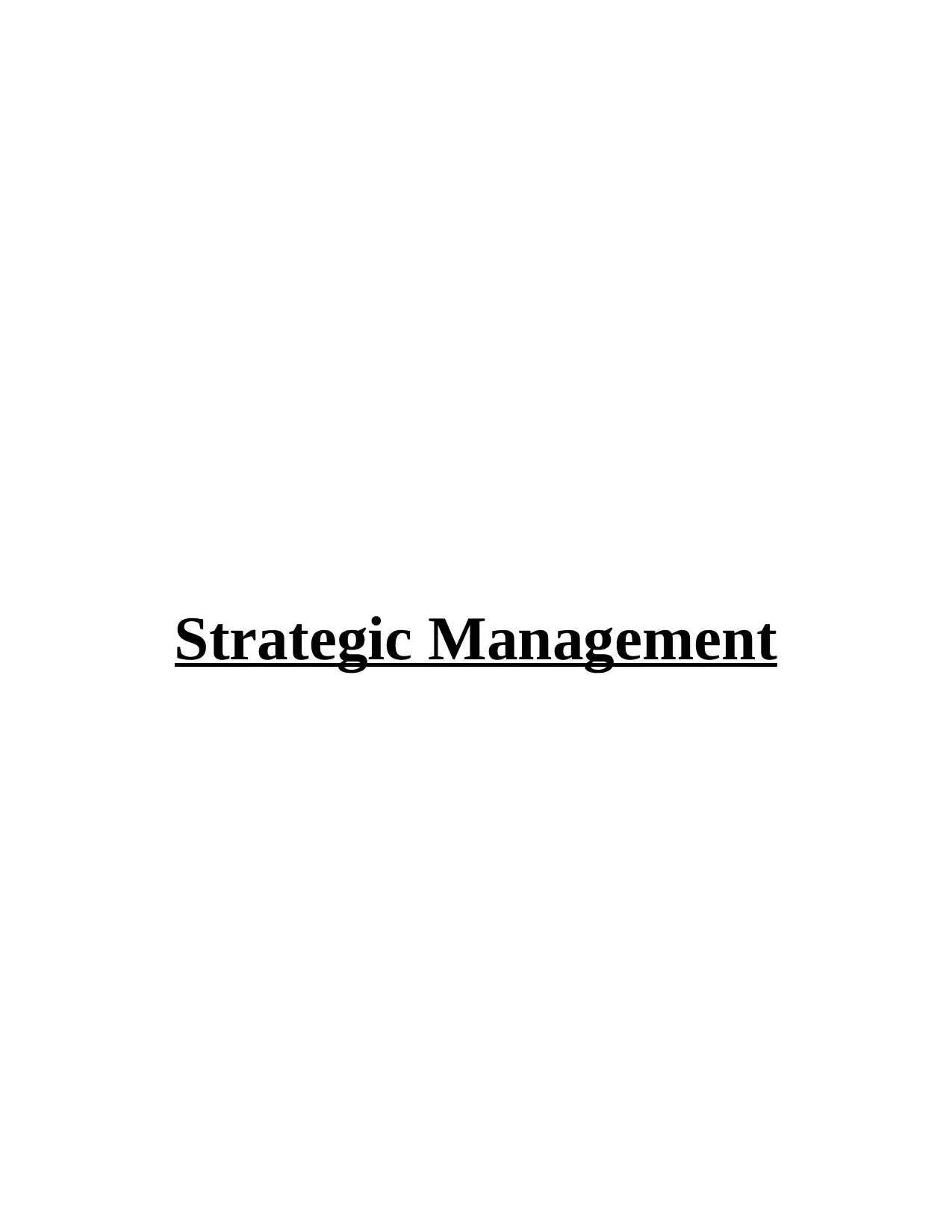
Strategic Management
Secure Best Marks with AI Grader
Need help grading? Try our AI Grader for instant feedback on your assignments.
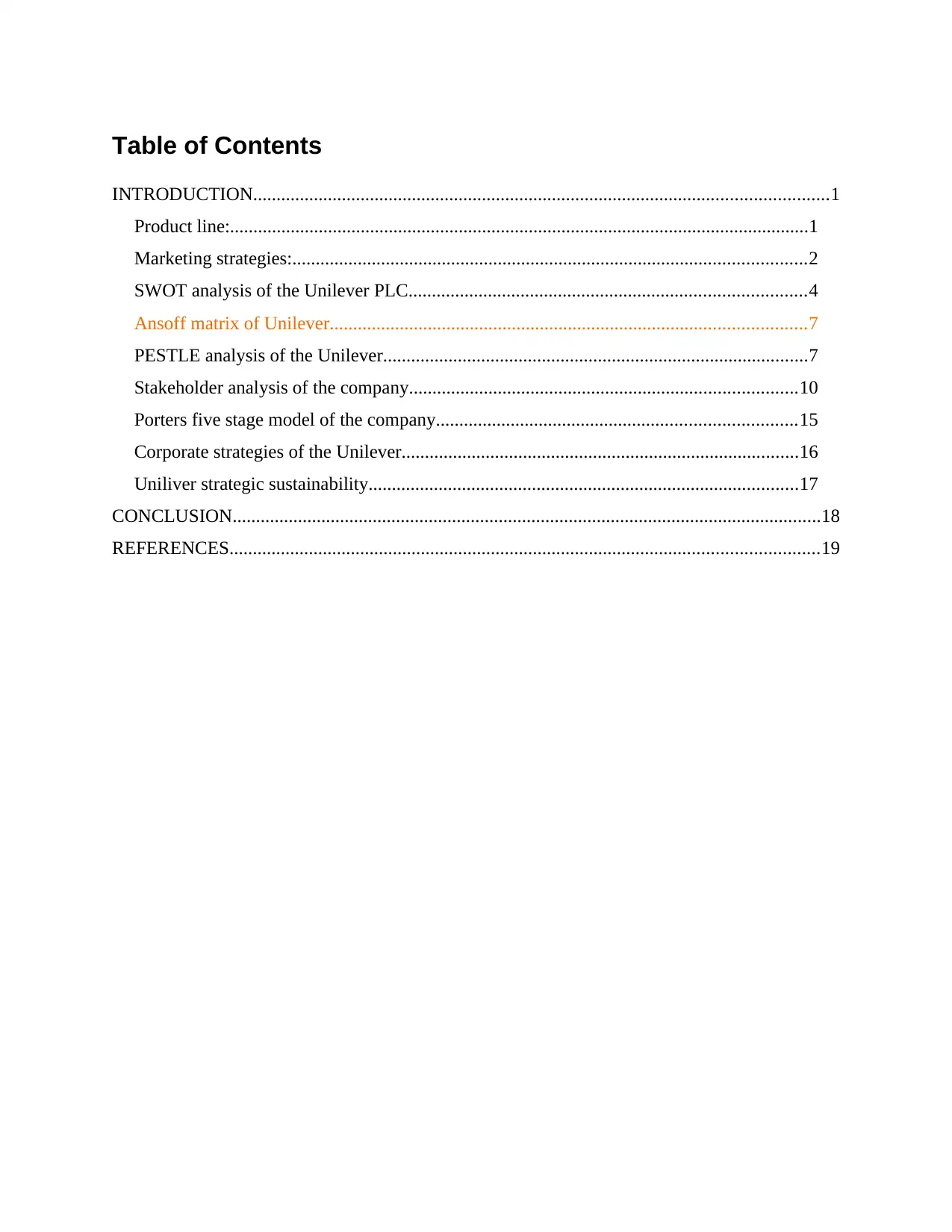
Table of Contents
INTRODUCTION...........................................................................................................................1
Product line:............................................................................................................................1
Marketing strategies:..............................................................................................................2
SWOT analysis of the Unilever PLC.....................................................................................4
Ansoff matrix of Unilever......................................................................................................7
PESTLE analysis of the Unilever...........................................................................................7
Stakeholder analysis of the company...................................................................................10
Porters five stage model of the company.............................................................................15
Corporate strategies of the Unilever.....................................................................................16
Uniliver strategic sustainability............................................................................................17
CONCLUSION..............................................................................................................................18
REFERENCES..............................................................................................................................19
INTRODUCTION...........................................................................................................................1
Product line:............................................................................................................................1
Marketing strategies:..............................................................................................................2
SWOT analysis of the Unilever PLC.....................................................................................4
Ansoff matrix of Unilever......................................................................................................7
PESTLE analysis of the Unilever...........................................................................................7
Stakeholder analysis of the company...................................................................................10
Porters five stage model of the company.............................................................................15
Corporate strategies of the Unilever.....................................................................................16
Uniliver strategic sustainability............................................................................................17
CONCLUSION..............................................................................................................................18
REFERENCES..............................................................................................................................19
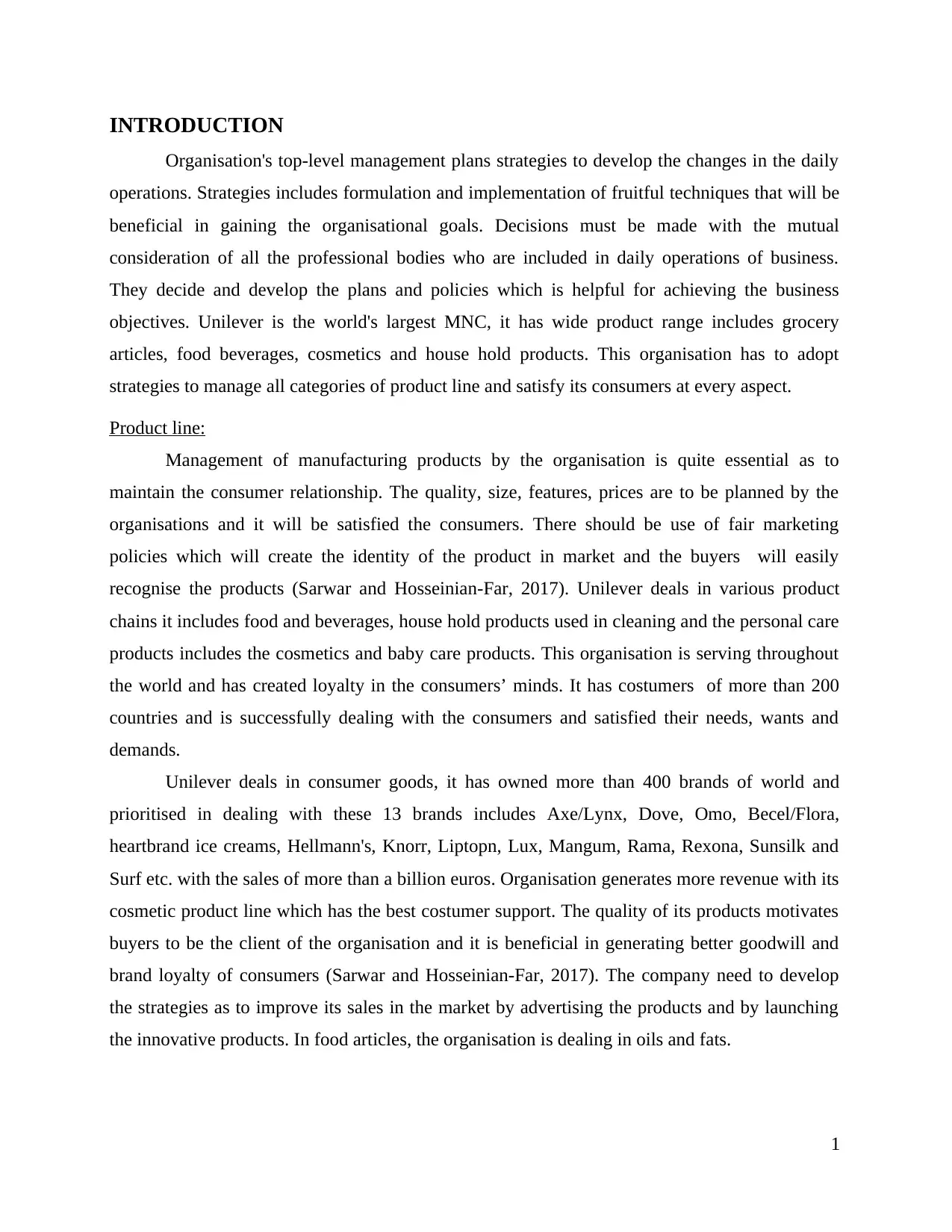
INTRODUCTION
Organisation's top-level management plans strategies to develop the changes in the daily
operations. Strategies includes formulation and implementation of fruitful techniques that will be
beneficial in gaining the organisational goals. Decisions must be made with the mutual
consideration of all the professional bodies who are included in daily operations of business.
They decide and develop the plans and policies which is helpful for achieving the business
objectives. Unilever is the world's largest MNC, it has wide product range includes grocery
articles, food beverages, cosmetics and house hold products. This organisation has to adopt
strategies to manage all categories of product line and satisfy its consumers at every aspect.
Product line:
Management of manufacturing products by the organisation is quite essential as to
maintain the consumer relationship. The quality, size, features, prices are to be planned by the
organisations and it will be satisfied the consumers. There should be use of fair marketing
policies which will create the identity of the product in market and the buyers will easily
recognise the products (Sarwar and Hosseinian-Far, 2017). Unilever deals in various product
chains it includes food and beverages, house hold products used in cleaning and the personal care
products includes the cosmetics and baby care products. This organisation is serving throughout
the world and has created loyalty in the consumers’ minds. It has costumers of more than 200
countries and is successfully dealing with the consumers and satisfied their needs, wants and
demands.
Unilever deals in consumer goods, it has owned more than 400 brands of world and
prioritised in dealing with these 13 brands includes Axe/Lynx, Dove, Omo, Becel/Flora,
heartbrand ice creams, Hellmann's, Knorr, Liptopn, Lux, Mangum, Rama, Rexona, Sunsilk and
Surf etc. with the sales of more than a billion euros. Organisation generates more revenue with its
cosmetic product line which has the best costumer support. The quality of its products motivates
buyers to be the client of the organisation and it is beneficial in generating better goodwill and
brand loyalty of consumers (Sarwar and Hosseinian-Far, 2017). The company need to develop
the strategies as to improve its sales in the market by advertising the products and by launching
the innovative products. In food articles, the organisation is dealing in oils and fats.
1
Organisation's top-level management plans strategies to develop the changes in the daily
operations. Strategies includes formulation and implementation of fruitful techniques that will be
beneficial in gaining the organisational goals. Decisions must be made with the mutual
consideration of all the professional bodies who are included in daily operations of business.
They decide and develop the plans and policies which is helpful for achieving the business
objectives. Unilever is the world's largest MNC, it has wide product range includes grocery
articles, food beverages, cosmetics and house hold products. This organisation has to adopt
strategies to manage all categories of product line and satisfy its consumers at every aspect.
Product line:
Management of manufacturing products by the organisation is quite essential as to
maintain the consumer relationship. The quality, size, features, prices are to be planned by the
organisations and it will be satisfied the consumers. There should be use of fair marketing
policies which will create the identity of the product in market and the buyers will easily
recognise the products (Sarwar and Hosseinian-Far, 2017). Unilever deals in various product
chains it includes food and beverages, house hold products used in cleaning and the personal care
products includes the cosmetics and baby care products. This organisation is serving throughout
the world and has created loyalty in the consumers’ minds. It has costumers of more than 200
countries and is successfully dealing with the consumers and satisfied their needs, wants and
demands.
Unilever deals in consumer goods, it has owned more than 400 brands of world and
prioritised in dealing with these 13 brands includes Axe/Lynx, Dove, Omo, Becel/Flora,
heartbrand ice creams, Hellmann's, Knorr, Liptopn, Lux, Mangum, Rama, Rexona, Sunsilk and
Surf etc. with the sales of more than a billion euros. Organisation generates more revenue with its
cosmetic product line which has the best costumer support. The quality of its products motivates
buyers to be the client of the organisation and it is beneficial in generating better goodwill and
brand loyalty of consumers (Sarwar and Hosseinian-Far, 2017). The company need to develop
the strategies as to improve its sales in the market by advertising the products and by launching
the innovative products. In food articles, the organisation is dealing in oils and fats.
1
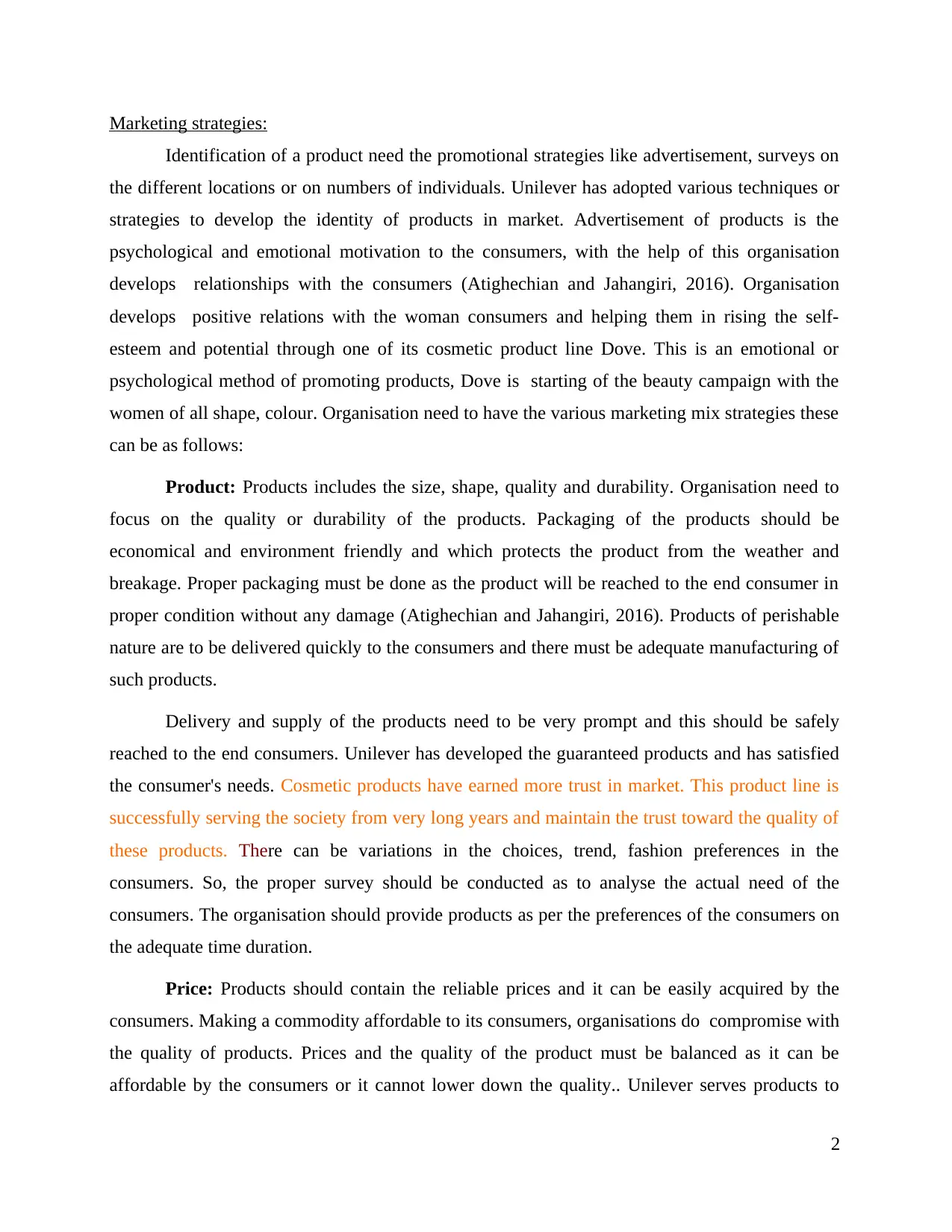
Marketing strategies:
Identification of a product need the promotional strategies like advertisement, surveys on
the different locations or on numbers of individuals. Unilever has adopted various techniques or
strategies to develop the identity of products in market. Advertisement of products is the
psychological and emotional motivation to the consumers, with the help of this organisation
develops relationships with the consumers (Atighechian and Jahangiri, 2016). Organisation
develops positive relations with the woman consumers and helping them in rising the self-
esteem and potential through one of its cosmetic product line Dove. This is an emotional or
psychological method of promoting products, Dove is starting of the beauty campaign with the
women of all shape, colour. Organisation need to have the various marketing mix strategies these
can be as follows:
Product: Products includes the size, shape, quality and durability. Organisation need to
focus on the quality or durability of the products. Packaging of the products should be
economical and environment friendly and which protects the product from the weather and
breakage. Proper packaging must be done as the product will be reached to the end consumer in
proper condition without any damage (Atighechian and Jahangiri, 2016). Products of perishable
nature are to be delivered quickly to the consumers and there must be adequate manufacturing of
such products.
Delivery and supply of the products need to be very prompt and this should be safely
reached to the end consumers. Unilever has developed the guaranteed products and has satisfied
the consumer's needs. Cosmetic products have earned more trust in market. This product line is
successfully serving the society from very long years and maintain the trust toward the quality of
these products. There can be variations in the choices, trend, fashion preferences in the
consumers. So, the proper survey should be conducted as to analyse the actual need of the
consumers. The organisation should provide products as per the preferences of the consumers on
the adequate time duration.
Price: Products should contain the reliable prices and it can be easily acquired by the
consumers. Making a commodity affordable to its consumers, organisations do compromise with
the quality of products. Prices and the quality of the product must be balanced as it can be
affordable by the consumers or it cannot lower down the quality.. Unilever serves products to
2
Identification of a product need the promotional strategies like advertisement, surveys on
the different locations or on numbers of individuals. Unilever has adopted various techniques or
strategies to develop the identity of products in market. Advertisement of products is the
psychological and emotional motivation to the consumers, with the help of this organisation
develops relationships with the consumers (Atighechian and Jahangiri, 2016). Organisation
develops positive relations with the woman consumers and helping them in rising the self-
esteem and potential through one of its cosmetic product line Dove. This is an emotional or
psychological method of promoting products, Dove is starting of the beauty campaign with the
women of all shape, colour. Organisation need to have the various marketing mix strategies these
can be as follows:
Product: Products includes the size, shape, quality and durability. Organisation need to
focus on the quality or durability of the products. Packaging of the products should be
economical and environment friendly and which protects the product from the weather and
breakage. Proper packaging must be done as the product will be reached to the end consumer in
proper condition without any damage (Atighechian and Jahangiri, 2016). Products of perishable
nature are to be delivered quickly to the consumers and there must be adequate manufacturing of
such products.
Delivery and supply of the products need to be very prompt and this should be safely
reached to the end consumers. Unilever has developed the guaranteed products and has satisfied
the consumer's needs. Cosmetic products have earned more trust in market. This product line is
successfully serving the society from very long years and maintain the trust toward the quality of
these products. There can be variations in the choices, trend, fashion preferences in the
consumers. So, the proper survey should be conducted as to analyse the actual need of the
consumers. The organisation should provide products as per the preferences of the consumers on
the adequate time duration.
Price: Products should contain the reliable prices and it can be easily acquired by the
consumers. Making a commodity affordable to its consumers, organisations do compromise with
the quality of products. Prices and the quality of the product must be balanced as it can be
affordable by the consumers or it cannot lower down the quality.. Unilever serves products to
2
Secure Best Marks with AI Grader
Need help grading? Try our AI Grader for instant feedback on your assignments.
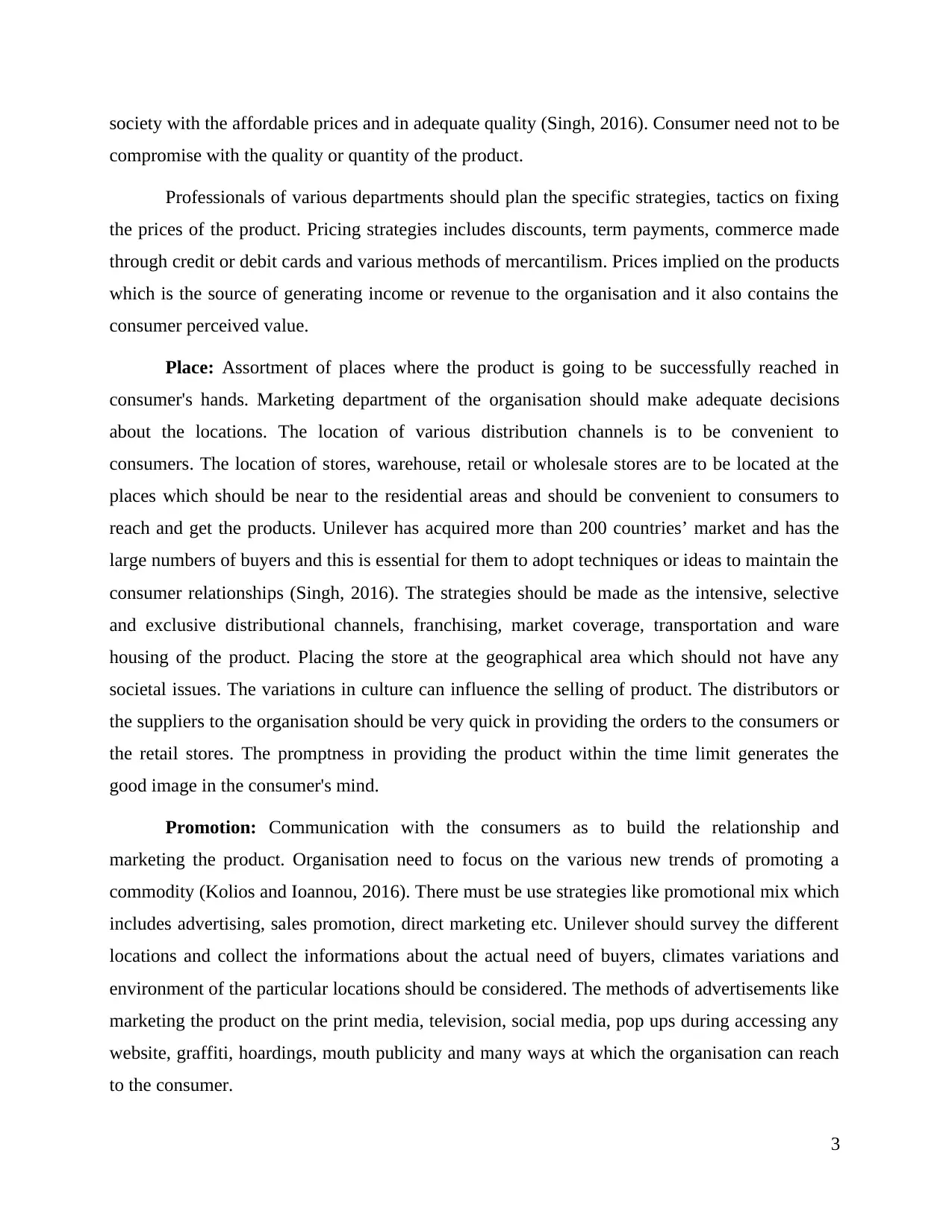
society with the affordable prices and in adequate quality (Singh, 2016). Consumer need not to be
compromise with the quality or quantity of the product.
Professionals of various departments should plan the specific strategies, tactics on fixing
the prices of the product. Pricing strategies includes discounts, term payments, commerce made
through credit or debit cards and various methods of mercantilism. Prices implied on the products
which is the source of generating income or revenue to the organisation and it also contains the
consumer perceived value.
Place: Assortment of places where the product is going to be successfully reached in
consumer's hands. Marketing department of the organisation should make adequate decisions
about the locations. The location of various distribution channels is to be convenient to
consumers. The location of stores, warehouse, retail or wholesale stores are to be located at the
places which should be near to the residential areas and should be convenient to consumers to
reach and get the products. Unilever has acquired more than 200 countries’ market and has the
large numbers of buyers and this is essential for them to adopt techniques or ideas to maintain the
consumer relationships (Singh, 2016). The strategies should be made as the intensive, selective
and exclusive distributional channels, franchising, market coverage, transportation and ware
housing of the product. Placing the store at the geographical area which should not have any
societal issues. The variations in culture can influence the selling of product. The distributors or
the suppliers to the organisation should be very quick in providing the orders to the consumers or
the retail stores. The promptness in providing the product within the time limit generates the
good image in the consumer's mind.
Promotion: Communication with the consumers as to build the relationship and
marketing the product. Organisation need to focus on the various new trends of promoting a
commodity (Kolios and Ioannou, 2016). There must be use strategies like promotional mix which
includes advertising, sales promotion, direct marketing etc. Unilever should survey the different
locations and collect the informations about the actual need of buyers, climates variations and
environment of the particular locations should be considered. The methods of advertisements like
marketing the product on the print media, television, social media, pop ups during accessing any
website, graffiti, hoardings, mouth publicity and many ways at which the organisation can reach
to the consumer.
3
compromise with the quality or quantity of the product.
Professionals of various departments should plan the specific strategies, tactics on fixing
the prices of the product. Pricing strategies includes discounts, term payments, commerce made
through credit or debit cards and various methods of mercantilism. Prices implied on the products
which is the source of generating income or revenue to the organisation and it also contains the
consumer perceived value.
Place: Assortment of places where the product is going to be successfully reached in
consumer's hands. Marketing department of the organisation should make adequate decisions
about the locations. The location of various distribution channels is to be convenient to
consumers. The location of stores, warehouse, retail or wholesale stores are to be located at the
places which should be near to the residential areas and should be convenient to consumers to
reach and get the products. Unilever has acquired more than 200 countries’ market and has the
large numbers of buyers and this is essential for them to adopt techniques or ideas to maintain the
consumer relationships (Singh, 2016). The strategies should be made as the intensive, selective
and exclusive distributional channels, franchising, market coverage, transportation and ware
housing of the product. Placing the store at the geographical area which should not have any
societal issues. The variations in culture can influence the selling of product. The distributors or
the suppliers to the organisation should be very quick in providing the orders to the consumers or
the retail stores. The promptness in providing the product within the time limit generates the
good image in the consumer's mind.
Promotion: Communication with the consumers as to build the relationship and
marketing the product. Organisation need to focus on the various new trends of promoting a
commodity (Kolios and Ioannou, 2016). There must be use strategies like promotional mix which
includes advertising, sales promotion, direct marketing etc. Unilever should survey the different
locations and collect the informations about the actual need of buyers, climates variations and
environment of the particular locations should be considered. The methods of advertisements like
marketing the product on the print media, television, social media, pop ups during accessing any
website, graffiti, hoardings, mouth publicity and many ways at which the organisation can reach
to the consumer.
3
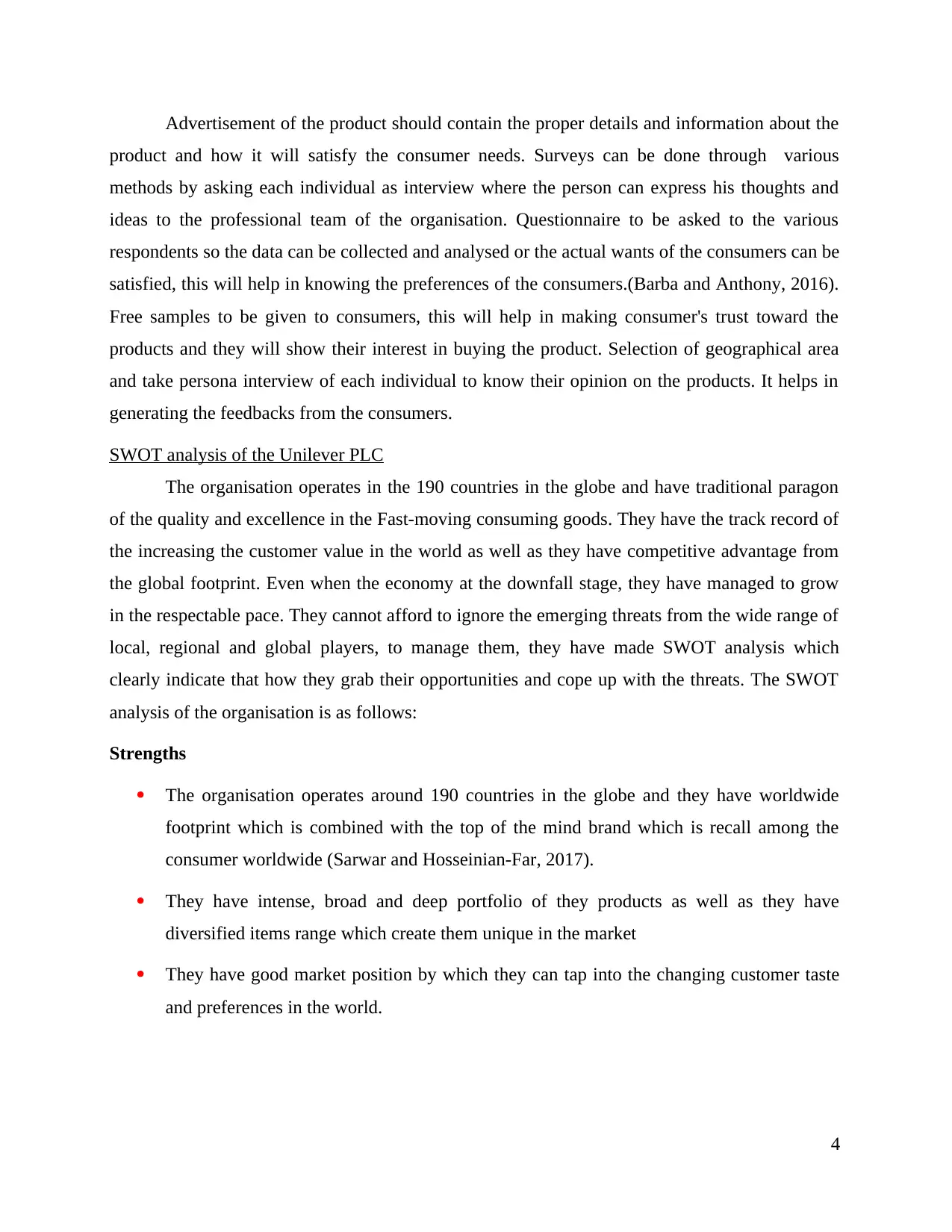
Advertisement of the product should contain the proper details and information about the
product and how it will satisfy the consumer needs. Surveys can be done through various
methods by asking each individual as interview where the person can express his thoughts and
ideas to the professional team of the organisation. Questionnaire to be asked to the various
respondents so the data can be collected and analysed or the actual wants of the consumers can be
satisfied, this will help in knowing the preferences of the consumers.(Barba and Anthony, 2016).
Free samples to be given to consumers, this will help in making consumer's trust toward the
products and they will show their interest in buying the product. Selection of geographical area
and take persona interview of each individual to know their opinion on the products. It helps in
generating the feedbacks from the consumers.
SWOT analysis of the Unilever PLC
The organisation operates in the 190 countries in the globe and have traditional paragon
of the quality and excellence in the Fast-moving consuming goods. They have the track record of
the increasing the customer value in the world as well as they have competitive advantage from
the global footprint. Even when the economy at the downfall stage, they have managed to grow
in the respectable pace. They cannot afford to ignore the emerging threats from the wide range of
local, regional and global players, to manage them, they have made SWOT analysis which
clearly indicate that how they grab their opportunities and cope up with the threats. The SWOT
analysis of the organisation is as follows:
Strengths
The organisation operates around 190 countries in the globe and they have worldwide
footprint which is combined with the top of the mind brand which is recall among the
consumer worldwide (Sarwar and Hosseinian-Far, 2017).
They have intense, broad and deep portfolio of they products as well as they have
diversified items range which create them unique in the market
They have good market position by which they can tap into the changing customer taste
and preferences in the world.
4
product and how it will satisfy the consumer needs. Surveys can be done through various
methods by asking each individual as interview where the person can express his thoughts and
ideas to the professional team of the organisation. Questionnaire to be asked to the various
respondents so the data can be collected and analysed or the actual wants of the consumers can be
satisfied, this will help in knowing the preferences of the consumers.(Barba and Anthony, 2016).
Free samples to be given to consumers, this will help in making consumer's trust toward the
products and they will show their interest in buying the product. Selection of geographical area
and take persona interview of each individual to know their opinion on the products. It helps in
generating the feedbacks from the consumers.
SWOT analysis of the Unilever PLC
The organisation operates in the 190 countries in the globe and have traditional paragon
of the quality and excellence in the Fast-moving consuming goods. They have the track record of
the increasing the customer value in the world as well as they have competitive advantage from
the global footprint. Even when the economy at the downfall stage, they have managed to grow
in the respectable pace. They cannot afford to ignore the emerging threats from the wide range of
local, regional and global players, to manage them, they have made SWOT analysis which
clearly indicate that how they grab their opportunities and cope up with the threats. The SWOT
analysis of the organisation is as follows:
Strengths
The organisation operates around 190 countries in the globe and they have worldwide
footprint which is combined with the top of the mind brand which is recall among the
consumer worldwide (Sarwar and Hosseinian-Far, 2017).
They have intense, broad and deep portfolio of they products as well as they have
diversified items range which create them unique in the market
They have good market position by which they can tap into the changing customer taste
and preferences in the world.
4
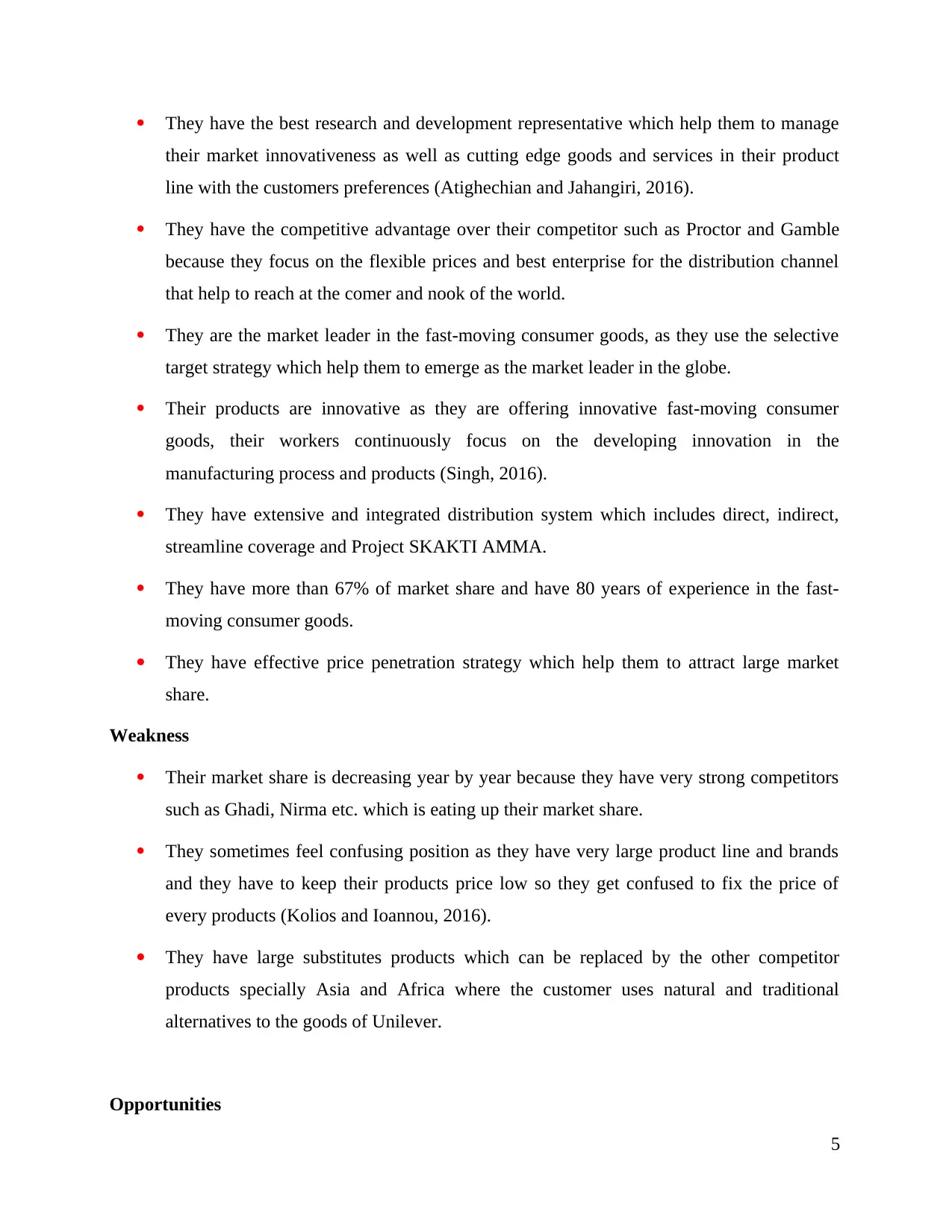
They have the best research and development representative which help them to manage
their market innovativeness as well as cutting edge goods and services in their product
line with the customers preferences (Atighechian and Jahangiri, 2016).
They have the competitive advantage over their competitor such as Proctor and Gamble
because they focus on the flexible prices and best enterprise for the distribution channel
that help to reach at the comer and nook of the world.
They are the market leader in the fast-moving consumer goods, as they use the selective
target strategy which help them to emerge as the market leader in the globe.
Their products are innovative as they are offering innovative fast-moving consumer
goods, their workers continuously focus on the developing innovation in the
manufacturing process and products (Singh, 2016).
They have extensive and integrated distribution system which includes direct, indirect,
streamline coverage and Project SKAKTI AMMA.
They have more than 67% of market share and have 80 years of experience in the fast-
moving consumer goods.
They have effective price penetration strategy which help them to attract large market
share.
Weakness
Their market share is decreasing year by year because they have very strong competitors
such as Ghadi, Nirma etc. which is eating up their market share.
They sometimes feel confusing position as they have very large product line and brands
and they have to keep their products price low so they get confused to fix the price of
every products (Kolios and Ioannou, 2016).
They have large substitutes products which can be replaced by the other competitor
products specially Asia and Africa where the customer uses natural and traditional
alternatives to the goods of Unilever.
Opportunities
5
their market innovativeness as well as cutting edge goods and services in their product
line with the customers preferences (Atighechian and Jahangiri, 2016).
They have the competitive advantage over their competitor such as Proctor and Gamble
because they focus on the flexible prices and best enterprise for the distribution channel
that help to reach at the comer and nook of the world.
They are the market leader in the fast-moving consumer goods, as they use the selective
target strategy which help them to emerge as the market leader in the globe.
Their products are innovative as they are offering innovative fast-moving consumer
goods, their workers continuously focus on the developing innovation in the
manufacturing process and products (Singh, 2016).
They have extensive and integrated distribution system which includes direct, indirect,
streamline coverage and Project SKAKTI AMMA.
They have more than 67% of market share and have 80 years of experience in the fast-
moving consumer goods.
They have effective price penetration strategy which help them to attract large market
share.
Weakness
Their market share is decreasing year by year because they have very strong competitors
such as Ghadi, Nirma etc. which is eating up their market share.
They sometimes feel confusing position as they have very large product line and brands
and they have to keep their products price low so they get confused to fix the price of
every products (Kolios and Ioannou, 2016).
They have large substitutes products which can be replaced by the other competitor
products specially Asia and Africa where the customer uses natural and traditional
alternatives to the goods of Unilever.
Opportunities
5
Paraphrase This Document
Need a fresh take? Get an instant paraphrase of this document with our AI Paraphraser
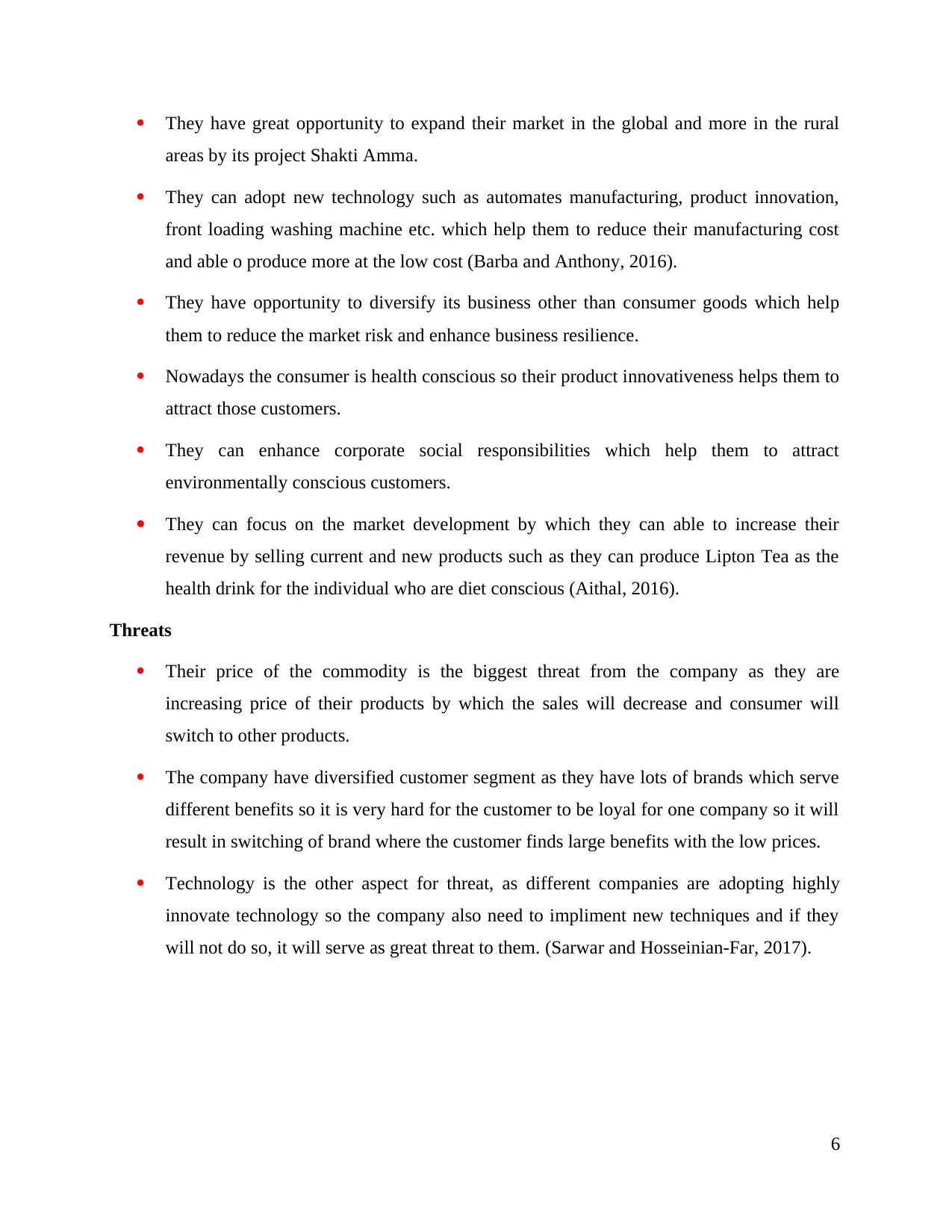
They have great opportunity to expand their market in the global and more in the rural
areas by its project Shakti Amma.
They can adopt new technology such as automates manufacturing, product innovation,
front loading washing machine etc. which help them to reduce their manufacturing cost
and able o produce more at the low cost (Barba and Anthony, 2016).
They have opportunity to diversify its business other than consumer goods which help
them to reduce the market risk and enhance business resilience.
Nowadays the consumer is health conscious so their product innovativeness helps them to
attract those customers.
They can enhance corporate social responsibilities which help them to attract
environmentally conscious customers.
They can focus on the market development by which they can able to increase their
revenue by selling current and new products such as they can produce Lipton Tea as the
health drink for the individual who are diet conscious (Aithal, 2016).
Threats
Their price of the commodity is the biggest threat from the company as they are
increasing price of their products by which the sales will decrease and consumer will
switch to other products.
The company have diversified customer segment as they have lots of brands which serve
different benefits so it is very hard for the customer to be loyal for one company so it will
result in switching of brand where the customer finds large benefits with the low prices.
Technology is the other aspect for threat, as different companies are adopting highly
innovate technology so the company also need to impliment new techniques and if they
will not do so, it will serve as great threat to them. (Sarwar and Hosseinian-Far, 2017).
6
areas by its project Shakti Amma.
They can adopt new technology such as automates manufacturing, product innovation,
front loading washing machine etc. which help them to reduce their manufacturing cost
and able o produce more at the low cost (Barba and Anthony, 2016).
They have opportunity to diversify its business other than consumer goods which help
them to reduce the market risk and enhance business resilience.
Nowadays the consumer is health conscious so their product innovativeness helps them to
attract those customers.
They can enhance corporate social responsibilities which help them to attract
environmentally conscious customers.
They can focus on the market development by which they can able to increase their
revenue by selling current and new products such as they can produce Lipton Tea as the
health drink for the individual who are diet conscious (Aithal, 2016).
Threats
Their price of the commodity is the biggest threat from the company as they are
increasing price of their products by which the sales will decrease and consumer will
switch to other products.
The company have diversified customer segment as they have lots of brands which serve
different benefits so it is very hard for the customer to be loyal for one company so it will
result in switching of brand where the customer finds large benefits with the low prices.
Technology is the other aspect for threat, as different companies are adopting highly
innovate technology so the company also need to impliment new techniques and if they
will not do so, it will serve as great threat to them. (Sarwar and Hosseinian-Far, 2017).
6
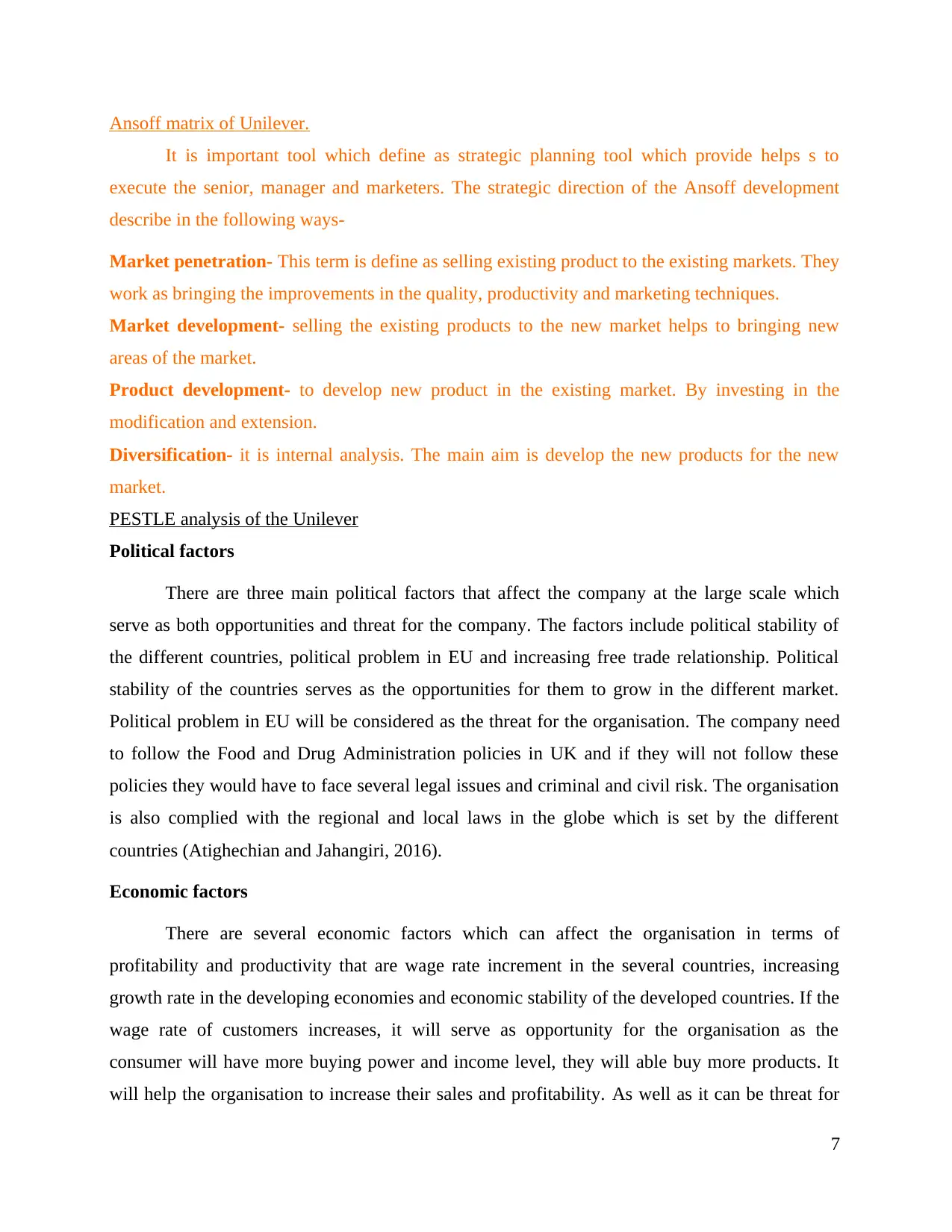
Ansoff matrix of Unilever.
It is important tool which define as strategic planning tool which provide helps s to
execute the senior, manager and marketers. The strategic direction of the Ansoff development
describe in the following ways-
Market penetration- This term is define as selling existing product to the existing markets. They
work as bringing the improvements in the quality, productivity and marketing techniques.
Market development- selling the existing products to the new market helps to bringing new
areas of the market.
Product development- to develop new product in the existing market. By investing in the
modification and extension.
Diversification- it is internal analysis. The main aim is develop the new products for the new
market.
PESTLE analysis of the Unilever
Political factors
There are three main political factors that affect the company at the large scale which
serve as both opportunities and threat for the company. The factors include political stability of
the different countries, political problem in EU and increasing free trade relationship. Political
stability of the countries serves as the opportunities for them to grow in the different market.
Political problem in EU will be considered as the threat for the organisation. The company need
to follow the Food and Drug Administration policies in UK and if they will not follow these
policies they would have to face several legal issues and criminal and civil risk. The organisation
is also complied with the regional and local laws in the globe which is set by the different
countries (Atighechian and Jahangiri, 2016).
Economic factors
There are several economic factors which can affect the organisation in terms of
profitability and productivity that are wage rate increment in the several countries, increasing
growth rate in the developing economies and economic stability of the developed countries. If the
wage rate of customers increases, it will serve as opportunity for the organisation as the
consumer will have more buying power and income level, they will able buy more products. It
will help the organisation to increase their sales and profitability. As well as it can be threat for
7
It is important tool which define as strategic planning tool which provide helps s to
execute the senior, manager and marketers. The strategic direction of the Ansoff development
describe in the following ways-
Market penetration- This term is define as selling existing product to the existing markets. They
work as bringing the improvements in the quality, productivity and marketing techniques.
Market development- selling the existing products to the new market helps to bringing new
areas of the market.
Product development- to develop new product in the existing market. By investing in the
modification and extension.
Diversification- it is internal analysis. The main aim is develop the new products for the new
market.
PESTLE analysis of the Unilever
Political factors
There are three main political factors that affect the company at the large scale which
serve as both opportunities and threat for the company. The factors include political stability of
the different countries, political problem in EU and increasing free trade relationship. Political
stability of the countries serves as the opportunities for them to grow in the different market.
Political problem in EU will be considered as the threat for the organisation. The company need
to follow the Food and Drug Administration policies in UK and if they will not follow these
policies they would have to face several legal issues and criminal and civil risk. The organisation
is also complied with the regional and local laws in the globe which is set by the different
countries (Atighechian and Jahangiri, 2016).
Economic factors
There are several economic factors which can affect the organisation in terms of
profitability and productivity that are wage rate increment in the several countries, increasing
growth rate in the developing economies and economic stability of the developed countries. If the
wage rate of customers increases, it will serve as opportunity for the organisation as the
consumer will have more buying power and income level, they will able buy more products. It
will help the organisation to increase their sales and profitability. As well as it can be threat for
7
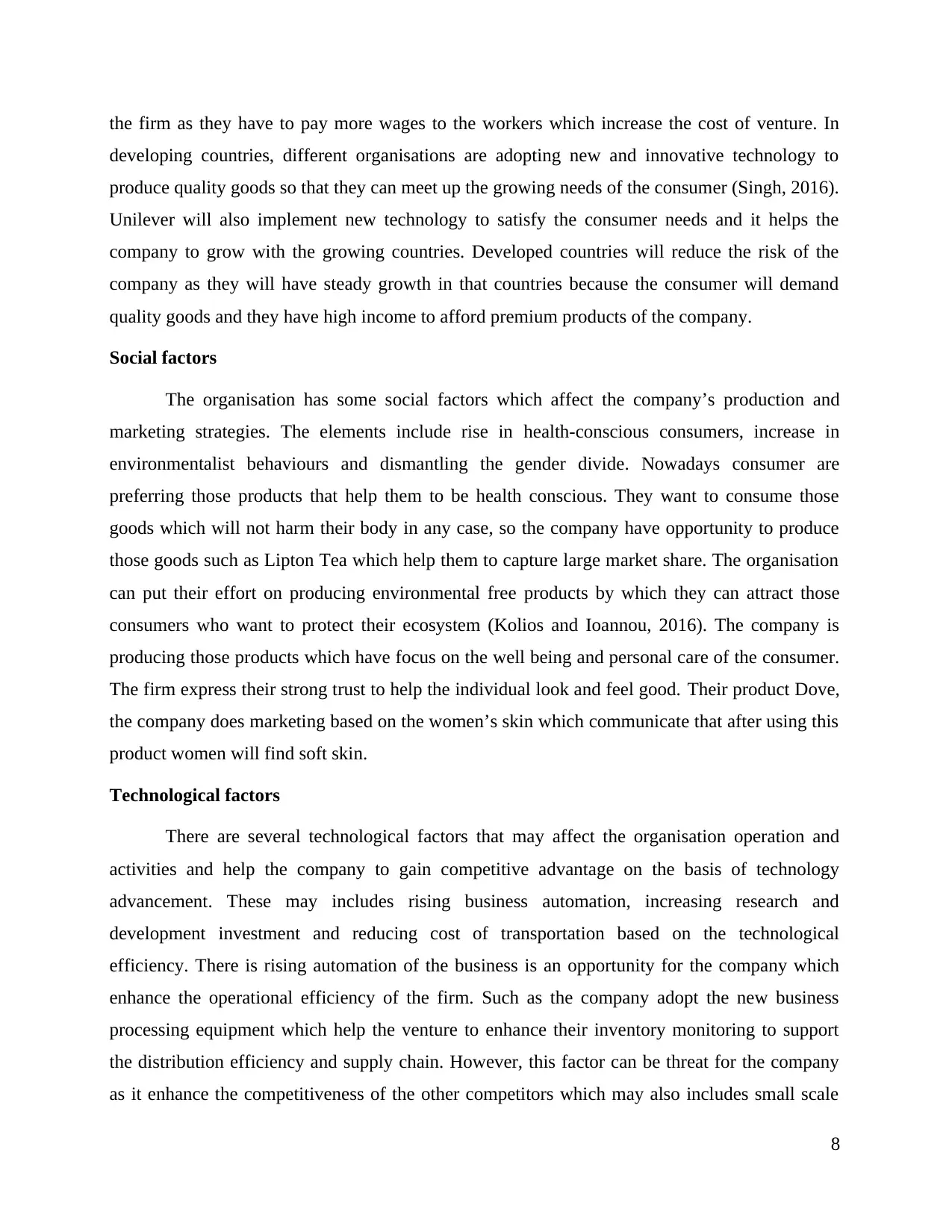
the firm as they have to pay more wages to the workers which increase the cost of venture. In
developing countries, different organisations are adopting new and innovative technology to
produce quality goods so that they can meet up the growing needs of the consumer (Singh, 2016).
Unilever will also implement new technology to satisfy the consumer needs and it helps the
company to grow with the growing countries. Developed countries will reduce the risk of the
company as they will have steady growth in that countries because the consumer will demand
quality goods and they have high income to afford premium products of the company.
Social factors
The organisation has some social factors which affect the company’s production and
marketing strategies. The elements include rise in health-conscious consumers, increase in
environmentalist behaviours and dismantling the gender divide. Nowadays consumer are
preferring those products that help them to be health conscious. They want to consume those
goods which will not harm their body in any case, so the company have opportunity to produce
those goods such as Lipton Tea which help them to capture large market share. The organisation
can put their effort on producing environmental free products by which they can attract those
consumers who want to protect their ecosystem (Kolios and Ioannou, 2016). The company is
producing those products which have focus on the well being and personal care of the consumer.
The firm express their strong trust to help the individual look and feel good. Their product Dove,
the company does marketing based on the women’s skin which communicate that after using this
product women will find soft skin.
Technological factors
There are several technological factors that may affect the organisation operation and
activities and help the company to gain competitive advantage on the basis of technology
advancement. These may includes rising business automation, increasing research and
development investment and reducing cost of transportation based on the technological
efficiency. There is rising automation of the business is an opportunity for the company which
enhance the operational efficiency of the firm. Such as the company adopt the new business
processing equipment which help the venture to enhance their inventory monitoring to support
the distribution efficiency and supply chain. However, this factor can be threat for the company
as it enhance the competitiveness of the other competitors which may also includes small scale
8
developing countries, different organisations are adopting new and innovative technology to
produce quality goods so that they can meet up the growing needs of the consumer (Singh, 2016).
Unilever will also implement new technology to satisfy the consumer needs and it helps the
company to grow with the growing countries. Developed countries will reduce the risk of the
company as they will have steady growth in that countries because the consumer will demand
quality goods and they have high income to afford premium products of the company.
Social factors
The organisation has some social factors which affect the company’s production and
marketing strategies. The elements include rise in health-conscious consumers, increase in
environmentalist behaviours and dismantling the gender divide. Nowadays consumer are
preferring those products that help them to be health conscious. They want to consume those
goods which will not harm their body in any case, so the company have opportunity to produce
those goods such as Lipton Tea which help them to capture large market share. The organisation
can put their effort on producing environmental free products by which they can attract those
consumers who want to protect their ecosystem (Kolios and Ioannou, 2016). The company is
producing those products which have focus on the well being and personal care of the consumer.
The firm express their strong trust to help the individual look and feel good. Their product Dove,
the company does marketing based on the women’s skin which communicate that after using this
product women will find soft skin.
Technological factors
There are several technological factors that may affect the organisation operation and
activities and help the company to gain competitive advantage on the basis of technology
advancement. These may includes rising business automation, increasing research and
development investment and reducing cost of transportation based on the technological
efficiency. There is rising automation of the business is an opportunity for the company which
enhance the operational efficiency of the firm. Such as the company adopt the new business
processing equipment which help the venture to enhance their inventory monitoring to support
the distribution efficiency and supply chain. However, this factor can be threat for the company
as it enhance the competitiveness of the other competitors which may also includes small scale
8
Secure Best Marks with AI Grader
Need help grading? Try our AI Grader for instant feedback on your assignments.
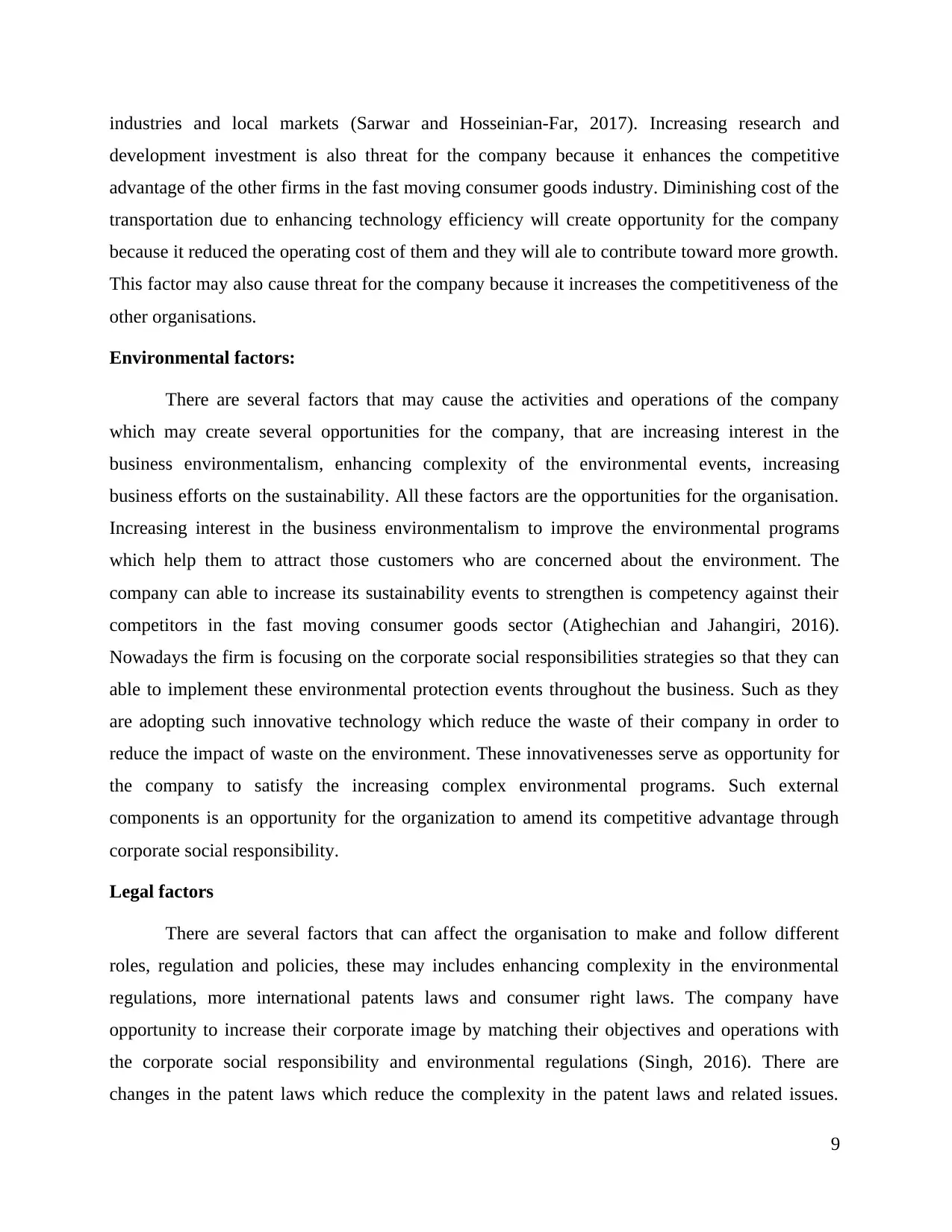
industries and local markets (Sarwar and Hosseinian-Far, 2017). Increasing research and
development investment is also threat for the company because it enhances the competitive
advantage of the other firms in the fast moving consumer goods industry. Diminishing cost of the
transportation due to enhancing technology efficiency will create opportunity for the company
because it reduced the operating cost of them and they will ale to contribute toward more growth.
This factor may also cause threat for the company because it increases the competitiveness of the
other organisations.
Environmental factors:
There are several factors that may cause the activities and operations of the company
which may create several opportunities for the company, that are increasing interest in the
business environmentalism, enhancing complexity of the environmental events, increasing
business efforts on the sustainability. All these factors are the opportunities for the organisation.
Increasing interest in the business environmentalism to improve the environmental programs
which help them to attract those customers who are concerned about the environment. The
company can able to increase its sustainability events to strengthen is competency against their
competitors in the fast moving consumer goods sector (Atighechian and Jahangiri, 2016).
Nowadays the firm is focusing on the corporate social responsibilities strategies so that they can
able to implement these environmental protection events throughout the business. Such as they
are adopting such innovative technology which reduce the waste of their company in order to
reduce the impact of waste on the environment. These innovativenesses serve as opportunity for
the company to satisfy the increasing complex environmental programs. Such external
components is an opportunity for the organization to amend its competitive advantage through
corporate social responsibility.
Legal factors
There are several factors that can affect the organisation to make and follow different
roles, regulation and policies, these may includes enhancing complexity in the environmental
regulations, more international patents laws and consumer right laws. The company have
opportunity to increase their corporate image by matching their objectives and operations with
the corporate social responsibility and environmental regulations (Singh, 2016). There are
changes in the patent laws which reduce the complexity in the patent laws and related issues.
9
development investment is also threat for the company because it enhances the competitive
advantage of the other firms in the fast moving consumer goods industry. Diminishing cost of the
transportation due to enhancing technology efficiency will create opportunity for the company
because it reduced the operating cost of them and they will ale to contribute toward more growth.
This factor may also cause threat for the company because it increases the competitiveness of the
other organisations.
Environmental factors:
There are several factors that may cause the activities and operations of the company
which may create several opportunities for the company, that are increasing interest in the
business environmentalism, enhancing complexity of the environmental events, increasing
business efforts on the sustainability. All these factors are the opportunities for the organisation.
Increasing interest in the business environmentalism to improve the environmental programs
which help them to attract those customers who are concerned about the environment. The
company can able to increase its sustainability events to strengthen is competency against their
competitors in the fast moving consumer goods sector (Atighechian and Jahangiri, 2016).
Nowadays the firm is focusing on the corporate social responsibilities strategies so that they can
able to implement these environmental protection events throughout the business. Such as they
are adopting such innovative technology which reduce the waste of their company in order to
reduce the impact of waste on the environment. These innovativenesses serve as opportunity for
the company to satisfy the increasing complex environmental programs. Such external
components is an opportunity for the organization to amend its competitive advantage through
corporate social responsibility.
Legal factors
There are several factors that can affect the organisation to make and follow different
roles, regulation and policies, these may includes enhancing complexity in the environmental
regulations, more international patents laws and consumer right laws. The company have
opportunity to increase their corporate image by matching their objectives and operations with
the corporate social responsibility and environmental regulations (Singh, 2016). There are
changes in the patent laws which reduce the complexity in the patent laws and related issues.
9
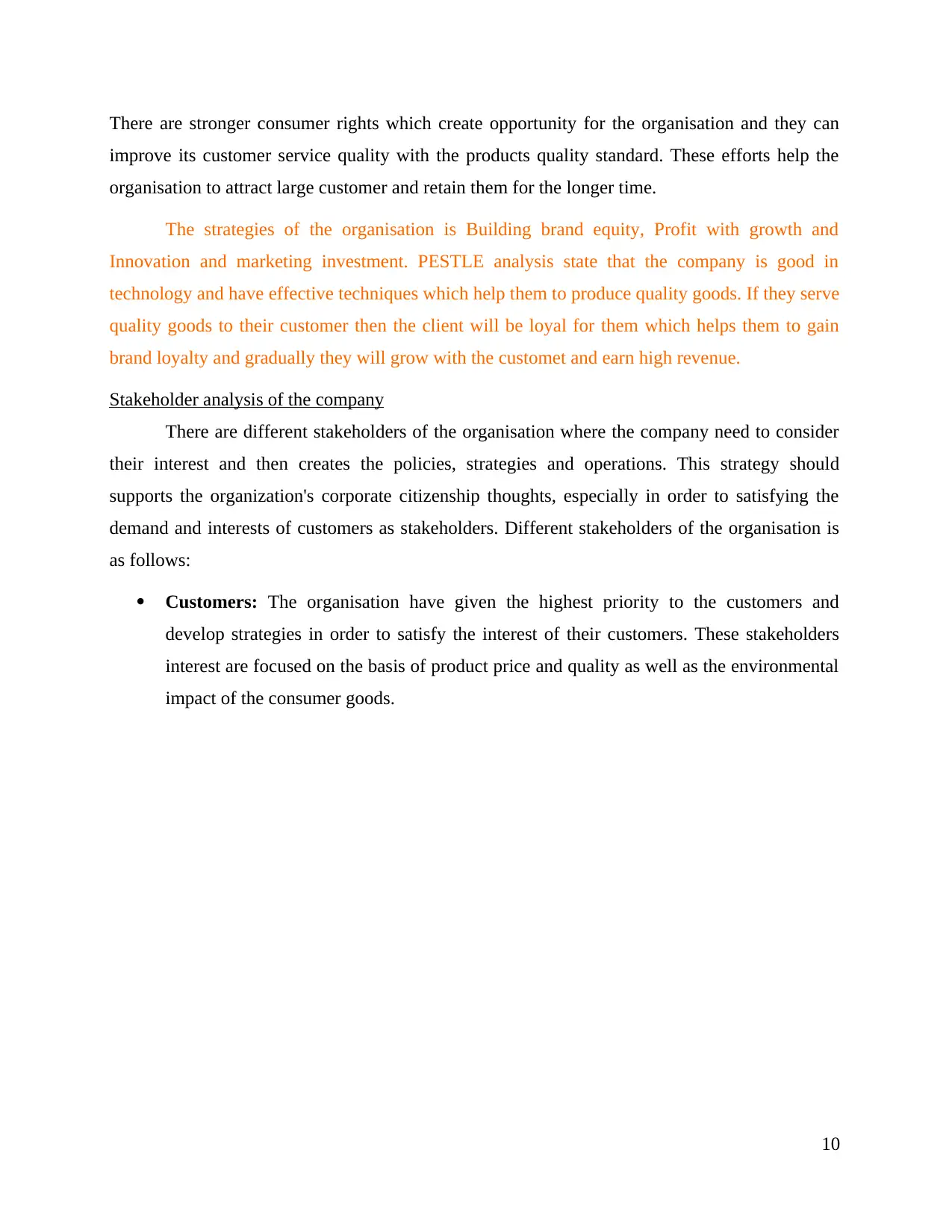
There are stronger consumer rights which create opportunity for the organisation and they can
improve its customer service quality with the products quality standard. These efforts help the
organisation to attract large customer and retain them for the longer time.
The strategies of the organisation is Building brand equity, Profit with growth and
Innovation and marketing investment. PESTLE analysis state that the company is good in
technology and have effective techniques which help them to produce quality goods. If they serve
quality goods to their customer then the client will be loyal for them which helps them to gain
brand loyalty and gradually they will grow with the customet and earn high revenue.
Stakeholder analysis of the company
There are different stakeholders of the organisation where the company need to consider
their interest and then creates the policies, strategies and operations. This strategy should
supports the organization's corporate citizenship thoughts, especially in order to satisfying the
demand and interests of customers as stakeholders. Different stakeholders of the organisation is
as follows:
Customers: The organisation have given the highest priority to the customers and
develop strategies in order to satisfy the interest of their customers. These stakeholders
interest are focused on the basis of product price and quality as well as the environmental
impact of the consumer goods.
10
improve its customer service quality with the products quality standard. These efforts help the
organisation to attract large customer and retain them for the longer time.
The strategies of the organisation is Building brand equity, Profit with growth and
Innovation and marketing investment. PESTLE analysis state that the company is good in
technology and have effective techniques which help them to produce quality goods. If they serve
quality goods to their customer then the client will be loyal for them which helps them to gain
brand loyalty and gradually they will grow with the customet and earn high revenue.
Stakeholder analysis of the company
There are different stakeholders of the organisation where the company need to consider
their interest and then creates the policies, strategies and operations. This strategy should
supports the organization's corporate citizenship thoughts, especially in order to satisfying the
demand and interests of customers as stakeholders. Different stakeholders of the organisation is
as follows:
Customers: The organisation have given the highest priority to the customers and
develop strategies in order to satisfy the interest of their customers. These stakeholders
interest are focused on the basis of product price and quality as well as the environmental
impact of the consumer goods.
10
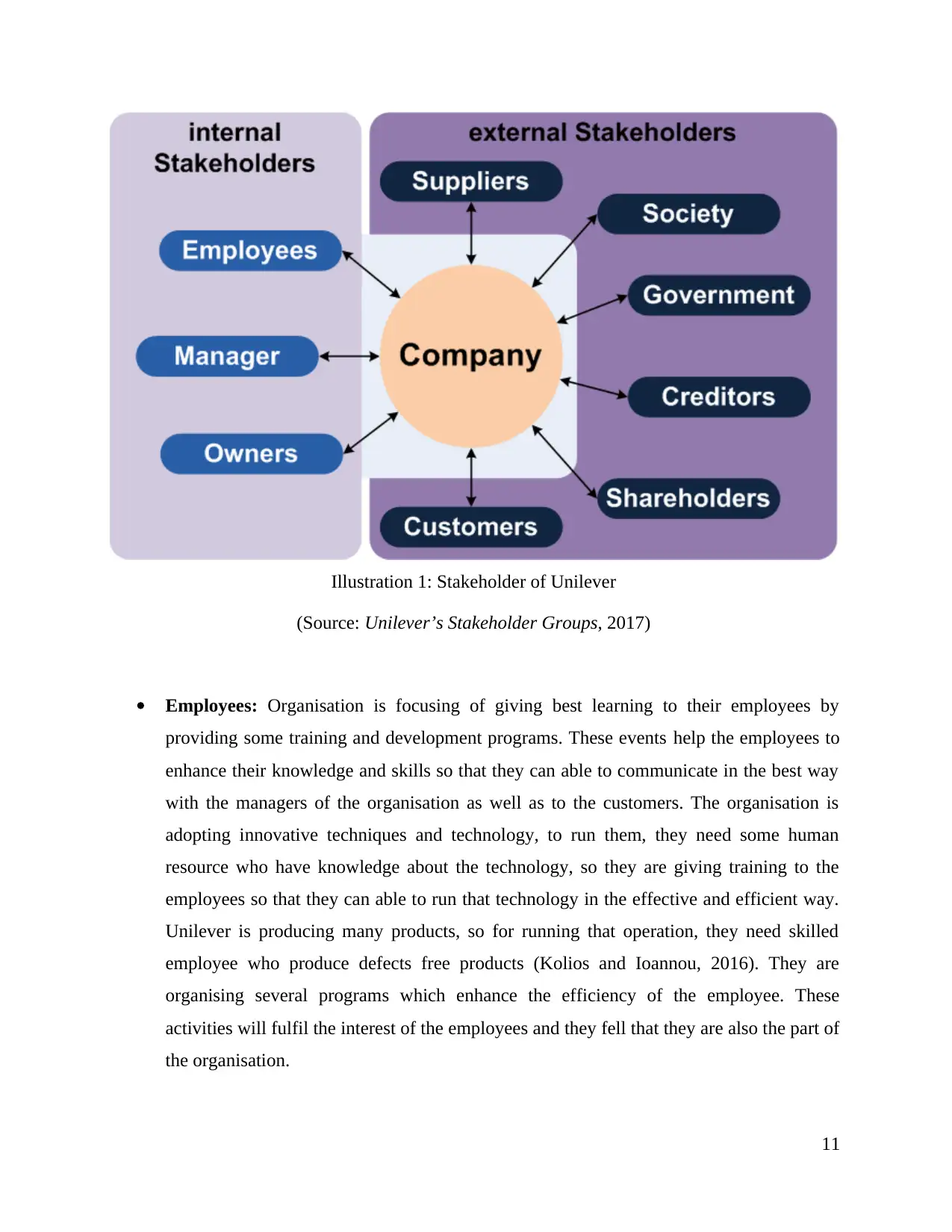
Illustration 1: Stakeholder of Unilever
(Source: Unilever’s Stakeholder Groups, 2017)
Employees: Organisation is focusing of giving best learning to their employees by
providing some training and development programs. These events help the employees to
enhance their knowledge and skills so that they can able to communicate in the best way
with the managers of the organisation as well as to the customers. The organisation is
adopting innovative techniques and technology, to run them, they need some human
resource who have knowledge about the technology, so they are giving training to the
employees so that they can able to run that technology in the effective and efficient way.
Unilever is producing many products, so for running that operation, they need skilled
employee who produce defects free products (Kolios and Ioannou, 2016). They are
organising several programs which enhance the efficiency of the employee. These
activities will fulfil the interest of the employees and they fell that they are also the part of
the organisation.
11
(Source: Unilever’s Stakeholder Groups, 2017)
Employees: Organisation is focusing of giving best learning to their employees by
providing some training and development programs. These events help the employees to
enhance their knowledge and skills so that they can able to communicate in the best way
with the managers of the organisation as well as to the customers. The organisation is
adopting innovative techniques and technology, to run them, they need some human
resource who have knowledge about the technology, so they are giving training to the
employees so that they can able to run that technology in the effective and efficient way.
Unilever is producing many products, so for running that operation, they need skilled
employee who produce defects free products (Kolios and Ioannou, 2016). They are
organising several programs which enhance the efficiency of the employee. These
activities will fulfil the interest of the employees and they fell that they are also the part of
the organisation.
11
Paraphrase This Document
Need a fresh take? Get an instant paraphrase of this document with our AI Paraphraser
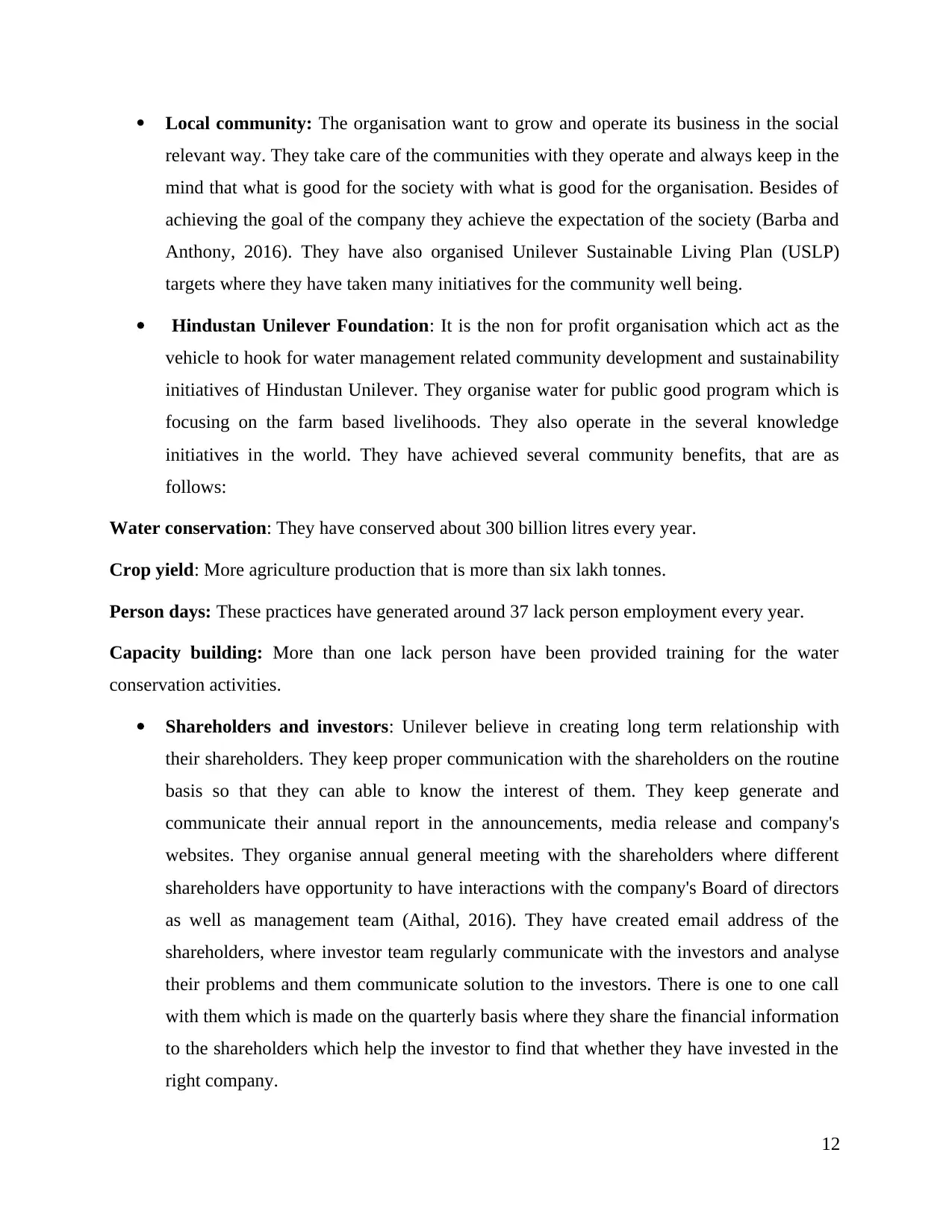
Local community: The organisation want to grow and operate its business in the social
relevant way. They take care of the communities with they operate and always keep in the
mind that what is good for the society with what is good for the organisation. Besides of
achieving the goal of the company they achieve the expectation of the society (Barba and
Anthony, 2016). They have also organised Unilever Sustainable Living Plan (USLP)
targets where they have taken many initiatives for the community well being.
Hindustan Unilever Foundation: It is the non for profit organisation which act as the
vehicle to hook for water management related community development and sustainability
initiatives of Hindustan Unilever. They organise water for public good program which is
focusing on the farm based livelihoods. They also operate in the several knowledge
initiatives in the world. They have achieved several community benefits, that are as
follows:
Water conservation: They have conserved about 300 billion litres every year.
Crop yield: More agriculture production that is more than six lakh tonnes.
Person days: These practices have generated around 37 lack person employment every year.
Capacity building: More than one lack person have been provided training for the water
conservation activities.
Shareholders and investors: Unilever believe in creating long term relationship with
their shareholders. They keep proper communication with the shareholders on the routine
basis so that they can able to know the interest of them. They keep generate and
communicate their annual report in the announcements, media release and company's
websites. They organise annual general meeting with the shareholders where different
shareholders have opportunity to have interactions with the company's Board of directors
as well as management team (Aithal, 2016). They have created email address of the
shareholders, where investor team regularly communicate with the investors and analyse
their problems and them communicate solution to the investors. There is one to one call
with them which is made on the quarterly basis where they share the financial information
to the shareholders which help the investor to find that whether they have invested in the
right company.
12
relevant way. They take care of the communities with they operate and always keep in the
mind that what is good for the society with what is good for the organisation. Besides of
achieving the goal of the company they achieve the expectation of the society (Barba and
Anthony, 2016). They have also organised Unilever Sustainable Living Plan (USLP)
targets where they have taken many initiatives for the community well being.
Hindustan Unilever Foundation: It is the non for profit organisation which act as the
vehicle to hook for water management related community development and sustainability
initiatives of Hindustan Unilever. They organise water for public good program which is
focusing on the farm based livelihoods. They also operate in the several knowledge
initiatives in the world. They have achieved several community benefits, that are as
follows:
Water conservation: They have conserved about 300 billion litres every year.
Crop yield: More agriculture production that is more than six lakh tonnes.
Person days: These practices have generated around 37 lack person employment every year.
Capacity building: More than one lack person have been provided training for the water
conservation activities.
Shareholders and investors: Unilever believe in creating long term relationship with
their shareholders. They keep proper communication with the shareholders on the routine
basis so that they can able to know the interest of them. They keep generate and
communicate their annual report in the announcements, media release and company's
websites. They organise annual general meeting with the shareholders where different
shareholders have opportunity to have interactions with the company's Board of directors
as well as management team (Aithal, 2016). They have created email address of the
shareholders, where investor team regularly communicate with the investors and analyse
their problems and them communicate solution to the investors. There is one to one call
with them which is made on the quarterly basis where they share the financial information
to the shareholders which help the investor to find that whether they have invested in the
right company.
12
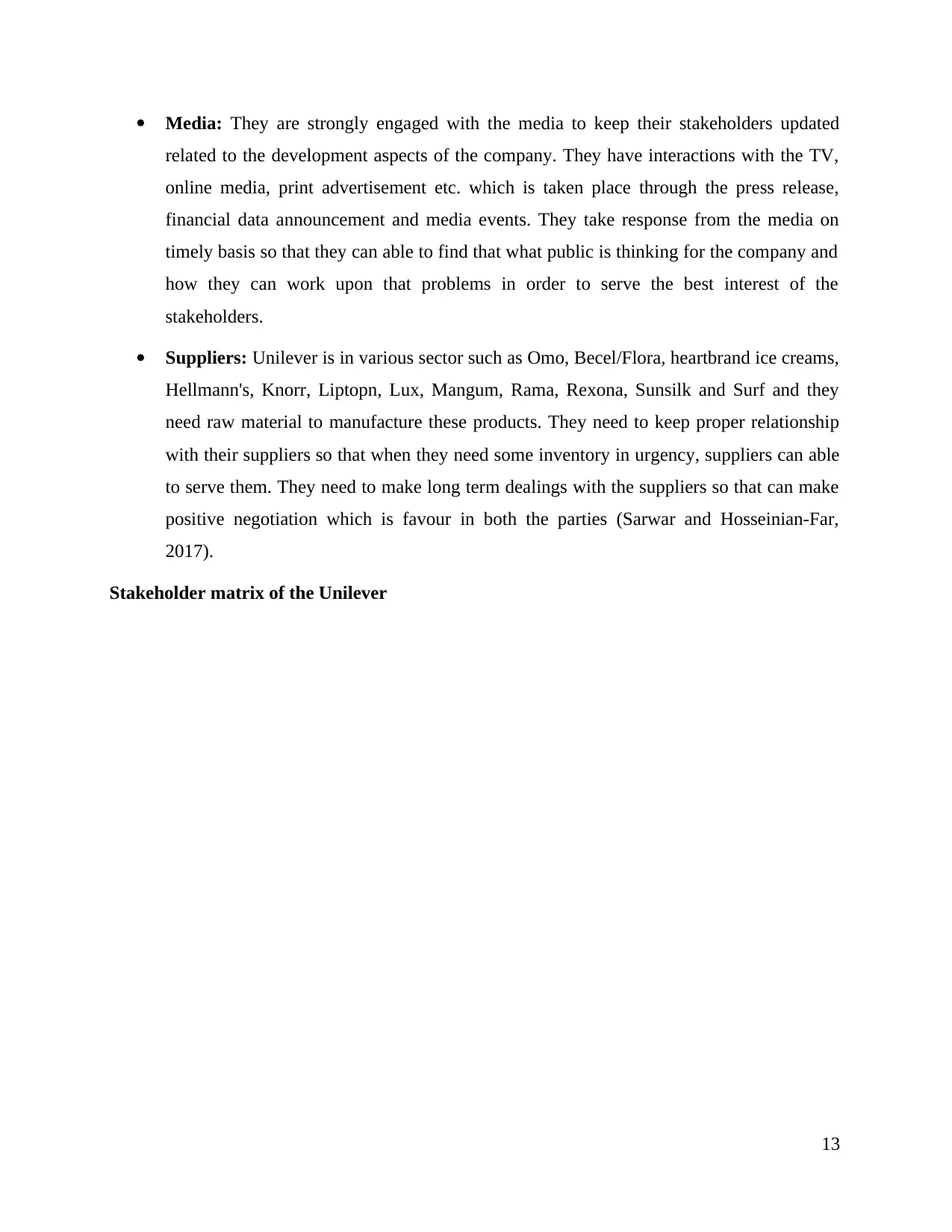
Media: They are strongly engaged with the media to keep their stakeholders updated
related to the development aspects of the company. They have interactions with the TV,
online media, print advertisement etc. which is taken place through the press release,
financial data announcement and media events. They take response from the media on
timely basis so that they can able to find that what public is thinking for the company and
how they can work upon that problems in order to serve the best interest of the
stakeholders.
Suppliers: Unilever is in various sector such as Omo, Becel/Flora, heartbrand ice creams,
Hellmann's, Knorr, Liptopn, Lux, Mangum, Rama, Rexona, Sunsilk and Surf and they
need raw material to manufacture these products. They need to keep proper relationship
with their suppliers so that when they need some inventory in urgency, suppliers can able
to serve them. They need to make long term dealings with the suppliers so that can make
positive negotiation which is favour in both the parties (Sarwar and Hosseinian-Far,
2017).
Stakeholder matrix of the Unilever
13
related to the development aspects of the company. They have interactions with the TV,
online media, print advertisement etc. which is taken place through the press release,
financial data announcement and media events. They take response from the media on
timely basis so that they can able to find that what public is thinking for the company and
how they can work upon that problems in order to serve the best interest of the
stakeholders.
Suppliers: Unilever is in various sector such as Omo, Becel/Flora, heartbrand ice creams,
Hellmann's, Knorr, Liptopn, Lux, Mangum, Rama, Rexona, Sunsilk and Surf and they
need raw material to manufacture these products. They need to keep proper relationship
with their suppliers so that when they need some inventory in urgency, suppliers can able
to serve them. They need to make long term dealings with the suppliers so that can make
positive negotiation which is favour in both the parties (Sarwar and Hosseinian-Far,
2017).
Stakeholder matrix of the Unilever
13
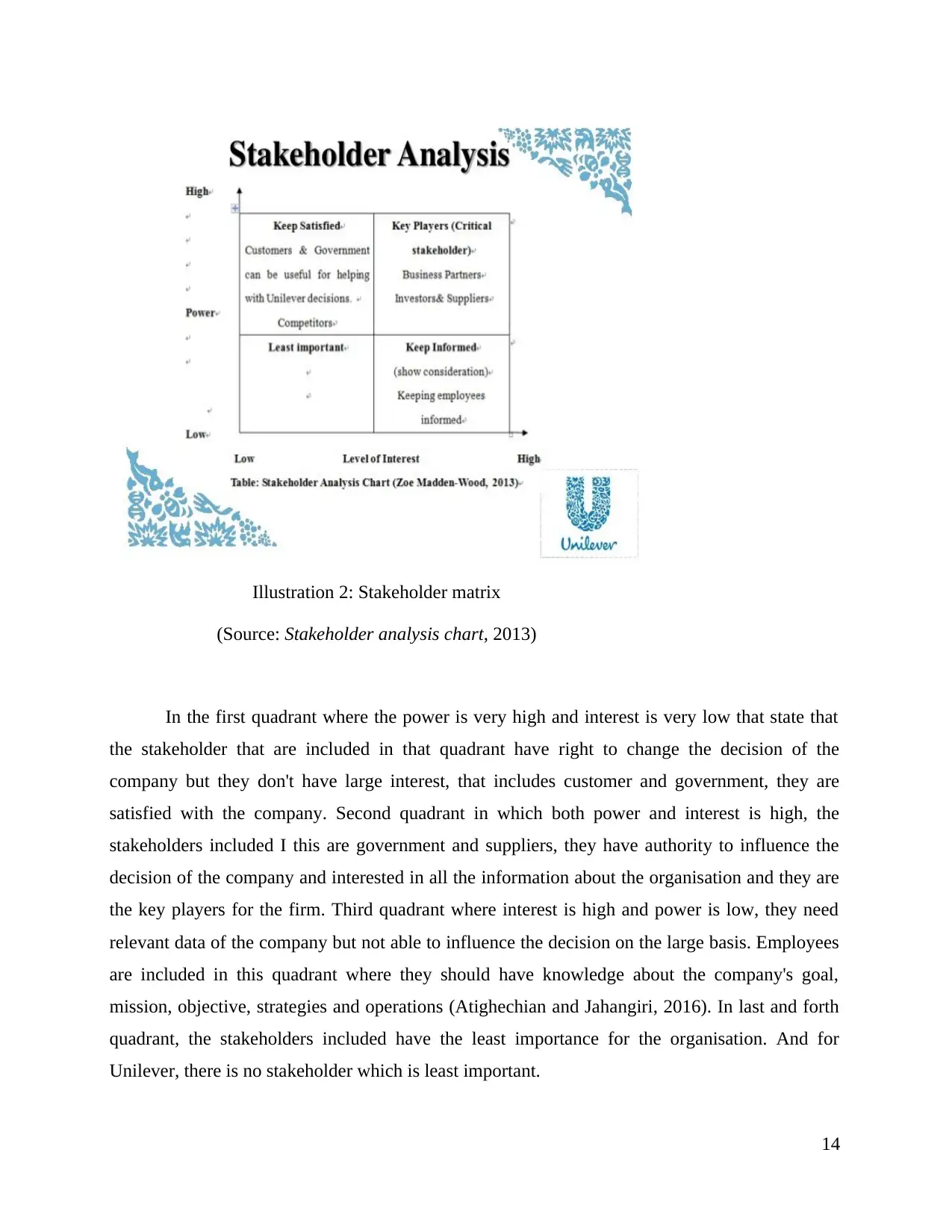
Illustration 2: Stakeholder matrix
(Source: Stakeholder analysis chart, 2013)
In the first quadrant where the power is very high and interest is very low that state that
the stakeholder that are included in that quadrant have right to change the decision of the
company but they don't have large interest, that includes customer and government, they are
satisfied with the company. Second quadrant in which both power and interest is high, the
stakeholders included I this are government and suppliers, they have authority to influence the
decision of the company and interested in all the information about the organisation and they are
the key players for the firm. Third quadrant where interest is high and power is low, they need
relevant data of the company but not able to influence the decision on the large basis. Employees
are included in this quadrant where they should have knowledge about the company's goal,
mission, objective, strategies and operations (Atighechian and Jahangiri, 2016). In last and forth
quadrant, the stakeholders included have the least importance for the organisation. And for
Unilever, there is no stakeholder which is least important.
14
(Source: Stakeholder analysis chart, 2013)
In the first quadrant where the power is very high and interest is very low that state that
the stakeholder that are included in that quadrant have right to change the decision of the
company but they don't have large interest, that includes customer and government, they are
satisfied with the company. Second quadrant in which both power and interest is high, the
stakeholders included I this are government and suppliers, they have authority to influence the
decision of the company and interested in all the information about the organisation and they are
the key players for the firm. Third quadrant where interest is high and power is low, they need
relevant data of the company but not able to influence the decision on the large basis. Employees
are included in this quadrant where they should have knowledge about the company's goal,
mission, objective, strategies and operations (Atighechian and Jahangiri, 2016). In last and forth
quadrant, the stakeholders included have the least importance for the organisation. And for
Unilever, there is no stakeholder which is least important.
14
Secure Best Marks with AI Grader
Need help grading? Try our AI Grader for instant feedback on your assignments.
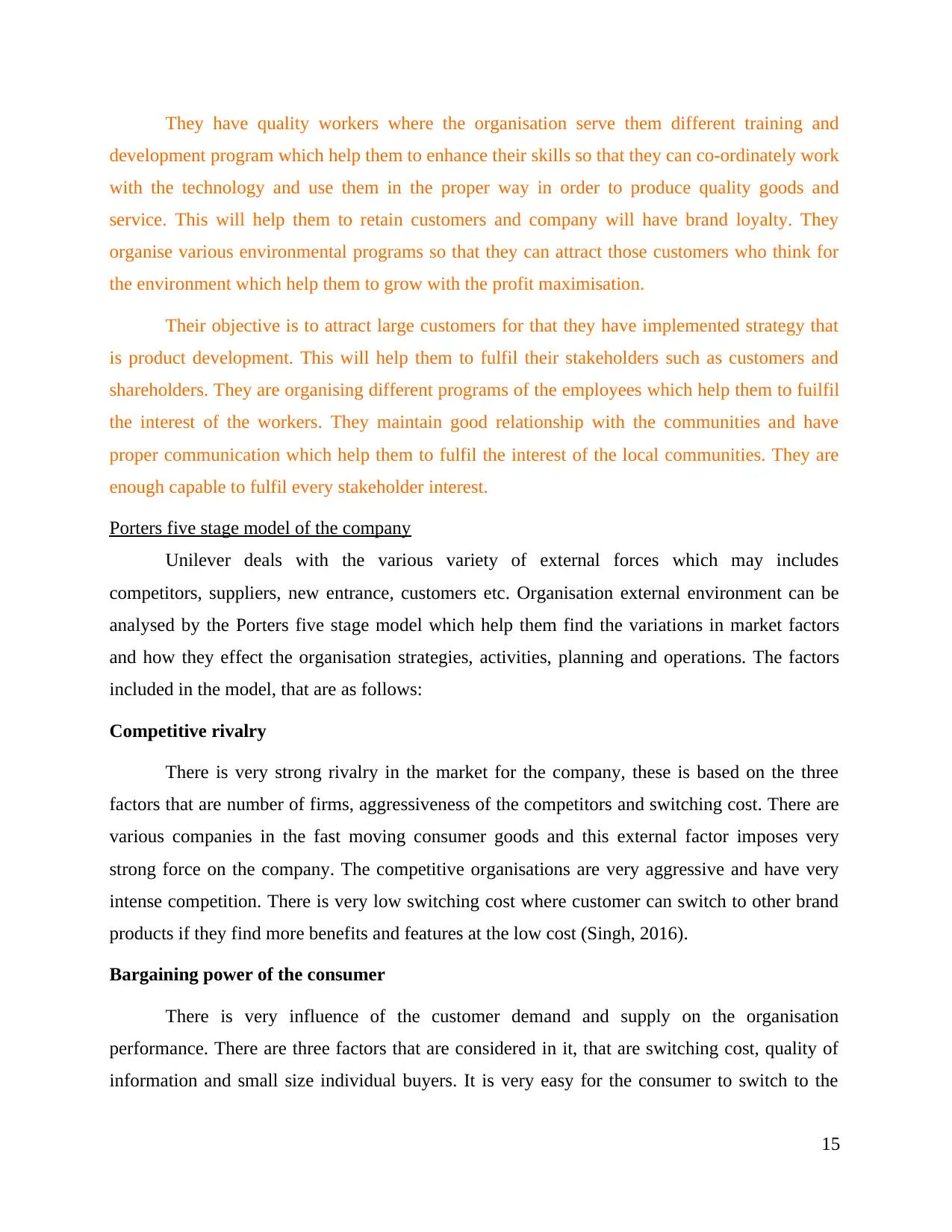
They have quality workers where the organisation serve them different training and
development program which help them to enhance their skills so that they can co-ordinately work
with the technology and use them in the proper way in order to produce quality goods and
service. This will help them to retain customers and company will have brand loyalty. They
organise various environmental programs so that they can attract those customers who think for
the environment which help them to grow with the profit maximisation.
Their objective is to attract large customers for that they have implemented strategy that
is product development. This will help them to fulfil their stakeholders such as customers and
shareholders. They are organising different programs of the employees which help them to fuilfil
the interest of the workers. They maintain good relationship with the communities and have
proper communication which help them to fulfil the interest of the local communities. They are
enough capable to fulfil every stakeholder interest.
Porters five stage model of the company
Unilever deals with the various variety of external forces which may includes
competitors, suppliers, new entrance, customers etc. Organisation external environment can be
analysed by the Porters five stage model which help them find the variations in market factors
and how they effect the organisation strategies, activities, planning and operations. The factors
included in the model, that are as follows:
Competitive rivalry
There is very strong rivalry in the market for the company, these is based on the three
factors that are number of firms, aggressiveness of the competitors and switching cost. There are
various companies in the fast moving consumer goods and this external factor imposes very
strong force on the company. The competitive organisations are very aggressive and have very
intense competition. There is very low switching cost where customer can switch to other brand
products if they find more benefits and features at the low cost (Singh, 2016).
Bargaining power of the consumer
There is very influence of the customer demand and supply on the organisation
performance. There are three factors that are considered in it, that are switching cost, quality of
information and small size individual buyers. It is very easy for the consumer to switch to the
15
development program which help them to enhance their skills so that they can co-ordinately work
with the technology and use them in the proper way in order to produce quality goods and
service. This will help them to retain customers and company will have brand loyalty. They
organise various environmental programs so that they can attract those customers who think for
the environment which help them to grow with the profit maximisation.
Their objective is to attract large customers for that they have implemented strategy that
is product development. This will help them to fulfil their stakeholders such as customers and
shareholders. They are organising different programs of the employees which help them to fuilfil
the interest of the workers. They maintain good relationship with the communities and have
proper communication which help them to fulfil the interest of the local communities. They are
enough capable to fulfil every stakeholder interest.
Porters five stage model of the company
Unilever deals with the various variety of external forces which may includes
competitors, suppliers, new entrance, customers etc. Organisation external environment can be
analysed by the Porters five stage model which help them find the variations in market factors
and how they effect the organisation strategies, activities, planning and operations. The factors
included in the model, that are as follows:
Competitive rivalry
There is very strong rivalry in the market for the company, these is based on the three
factors that are number of firms, aggressiveness of the competitors and switching cost. There are
various companies in the fast moving consumer goods and this external factor imposes very
strong force on the company. The competitive organisations are very aggressive and have very
intense competition. There is very low switching cost where customer can switch to other brand
products if they find more benefits and features at the low cost (Singh, 2016).
Bargaining power of the consumer
There is very influence of the customer demand and supply on the organisation
performance. There are three factors that are considered in it, that are switching cost, quality of
information and small size individual buyers. It is very easy for the consumer to switch to the
15
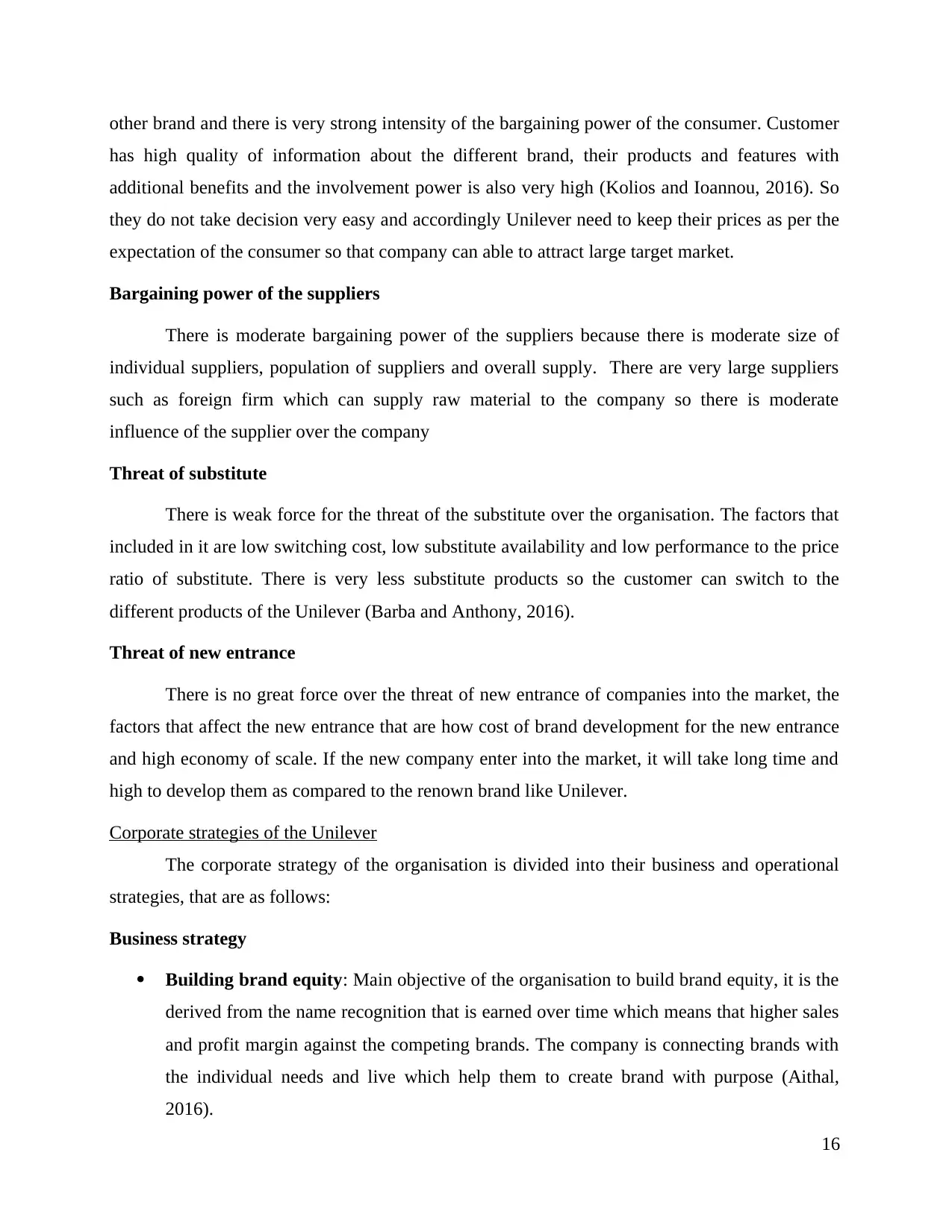
other brand and there is very strong intensity of the bargaining power of the consumer. Customer
has high quality of information about the different brand, their products and features with
additional benefits and the involvement power is also very high (Kolios and Ioannou, 2016). So
they do not take decision very easy and accordingly Unilever need to keep their prices as per the
expectation of the consumer so that company can able to attract large target market.
Bargaining power of the suppliers
There is moderate bargaining power of the suppliers because there is moderate size of
individual suppliers, population of suppliers and overall supply. There are very large suppliers
such as foreign firm which can supply raw material to the company so there is moderate
influence of the supplier over the company
Threat of substitute
There is weak force for the threat of the substitute over the organisation. The factors that
included in it are low switching cost, low substitute availability and low performance to the price
ratio of substitute. There is very less substitute products so the customer can switch to the
different products of the Unilever (Barba and Anthony, 2016).
Threat of new entrance
There is no great force over the threat of new entrance of companies into the market, the
factors that affect the new entrance that are how cost of brand development for the new entrance
and high economy of scale. If the new company enter into the market, it will take long time and
high to develop them as compared to the renown brand like Unilever.
Corporate strategies of the Unilever
The corporate strategy of the organisation is divided into their business and operational
strategies, that are as follows:
Business strategy
Building brand equity: Main objective of the organisation to build brand equity, it is the
derived from the name recognition that is earned over time which means that higher sales
and profit margin against the competing brands. The company is connecting brands with
the individual needs and live which help them to create brand with purpose (Aithal,
2016).
16
has high quality of information about the different brand, their products and features with
additional benefits and the involvement power is also very high (Kolios and Ioannou, 2016). So
they do not take decision very easy and accordingly Unilever need to keep their prices as per the
expectation of the consumer so that company can able to attract large target market.
Bargaining power of the suppliers
There is moderate bargaining power of the suppliers because there is moderate size of
individual suppliers, population of suppliers and overall supply. There are very large suppliers
such as foreign firm which can supply raw material to the company so there is moderate
influence of the supplier over the company
Threat of substitute
There is weak force for the threat of the substitute over the organisation. The factors that
included in it are low switching cost, low substitute availability and low performance to the price
ratio of substitute. There is very less substitute products so the customer can switch to the
different products of the Unilever (Barba and Anthony, 2016).
Threat of new entrance
There is no great force over the threat of new entrance of companies into the market, the
factors that affect the new entrance that are how cost of brand development for the new entrance
and high economy of scale. If the new company enter into the market, it will take long time and
high to develop them as compared to the renown brand like Unilever.
Corporate strategies of the Unilever
The corporate strategy of the organisation is divided into their business and operational
strategies, that are as follows:
Business strategy
Building brand equity: Main objective of the organisation to build brand equity, it is the
derived from the name recognition that is earned over time which means that higher sales
and profit margin against the competing brands. The company is connecting brands with
the individual needs and live which help them to create brand with purpose (Aithal,
2016).
16
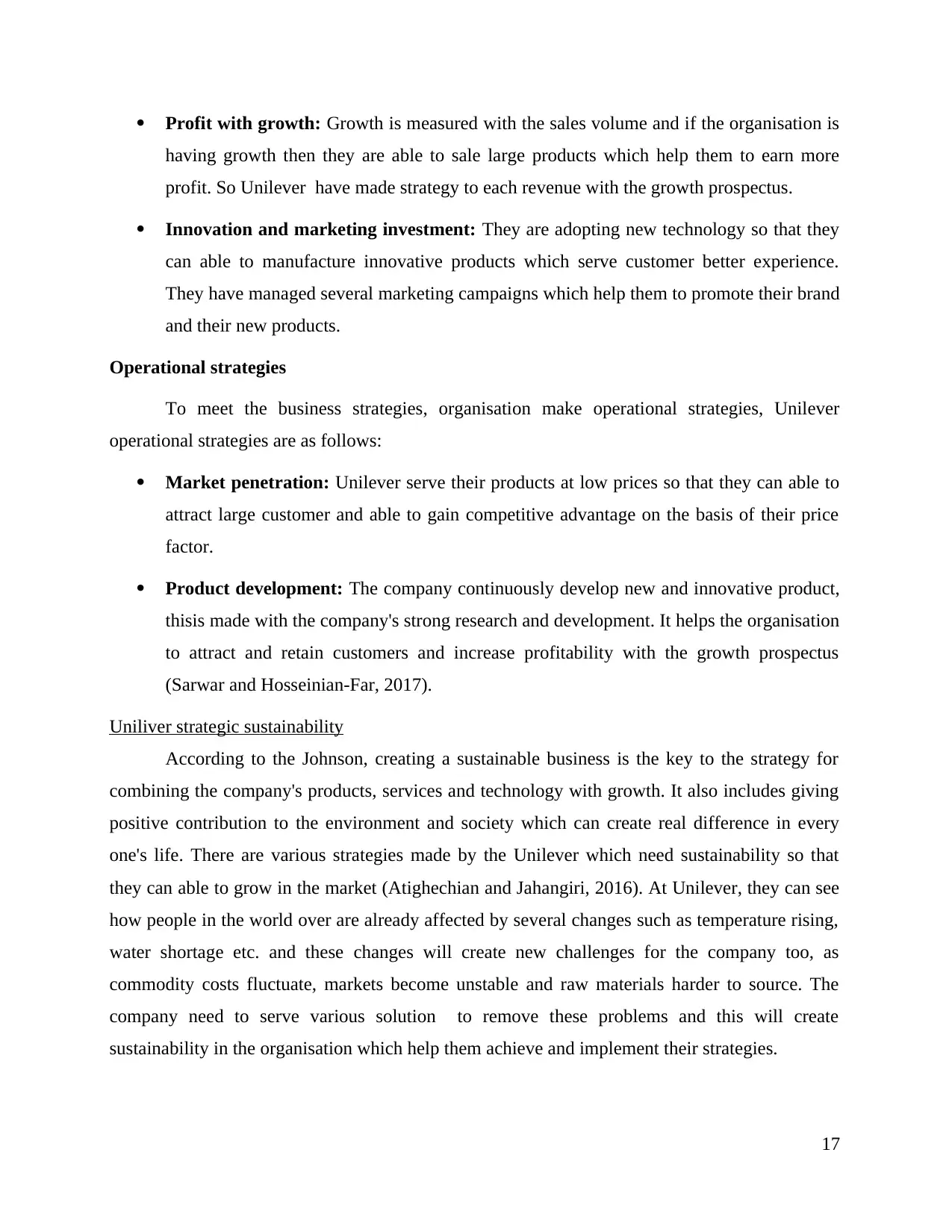
Profit with growth: Growth is measured with the sales volume and if the organisation is
having growth then they are able to sale large products which help them to earn more
profit. So Unilever have made strategy to each revenue with the growth prospectus.
Innovation and marketing investment: They are adopting new technology so that they
can able to manufacture innovative products which serve customer better experience.
They have managed several marketing campaigns which help them to promote their brand
and their new products.
Operational strategies
To meet the business strategies, organisation make operational strategies, Unilever
operational strategies are as follows:
Market penetration: Unilever serve their products at low prices so that they can able to
attract large customer and able to gain competitive advantage on the basis of their price
factor.
Product development: The company continuously develop new and innovative product,
thisis made with the company's strong research and development. It helps the organisation
to attract and retain customers and increase profitability with the growth prospectus
(Sarwar and Hosseinian-Far, 2017).
Uniliver strategic sustainability
According to the Johnson, creating a sustainable business is the key to the strategy for
combining the company's products, services and technology with growth. It also includes giving
positive contribution to the environment and society which can create real difference in every
one's life. There are various strategies made by the Unilever which need sustainability so that
they can able to grow in the market (Atighechian and Jahangiri, 2016). At Unilever, they can see
how people in the world over are already affected by several changes such as temperature rising,
water shortage etc. and these changes will create new challenges for the company too, as
commodity costs fluctuate, markets become unstable and raw materials harder to source. The
company need to serve various solution to remove these problems and this will create
sustainability in the organisation which help them achieve and implement their strategies.
17
having growth then they are able to sale large products which help them to earn more
profit. So Unilever have made strategy to each revenue with the growth prospectus.
Innovation and marketing investment: They are adopting new technology so that they
can able to manufacture innovative products which serve customer better experience.
They have managed several marketing campaigns which help them to promote their brand
and their new products.
Operational strategies
To meet the business strategies, organisation make operational strategies, Unilever
operational strategies are as follows:
Market penetration: Unilever serve their products at low prices so that they can able to
attract large customer and able to gain competitive advantage on the basis of their price
factor.
Product development: The company continuously develop new and innovative product,
thisis made with the company's strong research and development. It helps the organisation
to attract and retain customers and increase profitability with the growth prospectus
(Sarwar and Hosseinian-Far, 2017).
Uniliver strategic sustainability
According to the Johnson, creating a sustainable business is the key to the strategy for
combining the company's products, services and technology with growth. It also includes giving
positive contribution to the environment and society which can create real difference in every
one's life. There are various strategies made by the Unilever which need sustainability so that
they can able to grow in the market (Atighechian and Jahangiri, 2016). At Unilever, they can see
how people in the world over are already affected by several changes such as temperature rising,
water shortage etc. and these changes will create new challenges for the company too, as
commodity costs fluctuate, markets become unstable and raw materials harder to source. The
company need to serve various solution to remove these problems and this will create
sustainability in the organisation which help them achieve and implement their strategies.
17
Paraphrase This Document
Need a fresh take? Get an instant paraphrase of this document with our AI Paraphraser
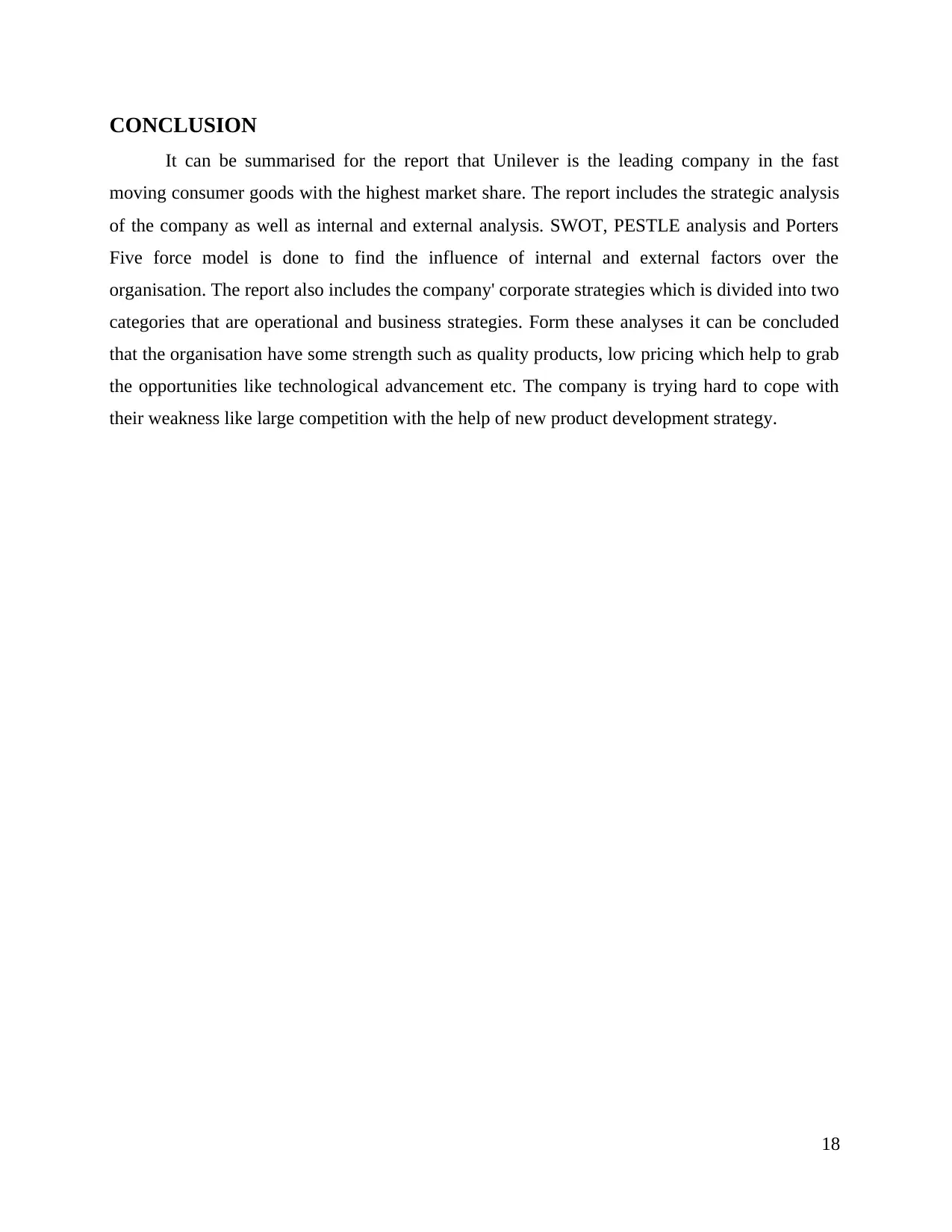
CONCLUSION
It can be summarised for the report that Unilever is the leading company in the fast
moving consumer goods with the highest market share. The report includes the strategic analysis
of the company as well as internal and external analysis. SWOT, PESTLE analysis and Porters
Five force model is done to find the influence of internal and external factors over the
organisation. The report also includes the company' corporate strategies which is divided into two
categories that are operational and business strategies. Form these analyses it can be concluded
that the organisation have some strength such as quality products, low pricing which help to grab
the opportunities like technological advancement etc. The company is trying hard to cope with
their weakness like large competition with the help of new product development strategy.
18
It can be summarised for the report that Unilever is the leading company in the fast
moving consumer goods with the highest market share. The report includes the strategic analysis
of the company as well as internal and external analysis. SWOT, PESTLE analysis and Porters
Five force model is done to find the influence of internal and external factors over the
organisation. The report also includes the company' corporate strategies which is divided into two
categories that are operational and business strategies. Form these analyses it can be concluded
that the organisation have some strength such as quality products, low pricing which help to grab
the opportunities like technological advancement etc. The company is trying hard to cope with
their weakness like large competition with the help of new product development strategy.
18
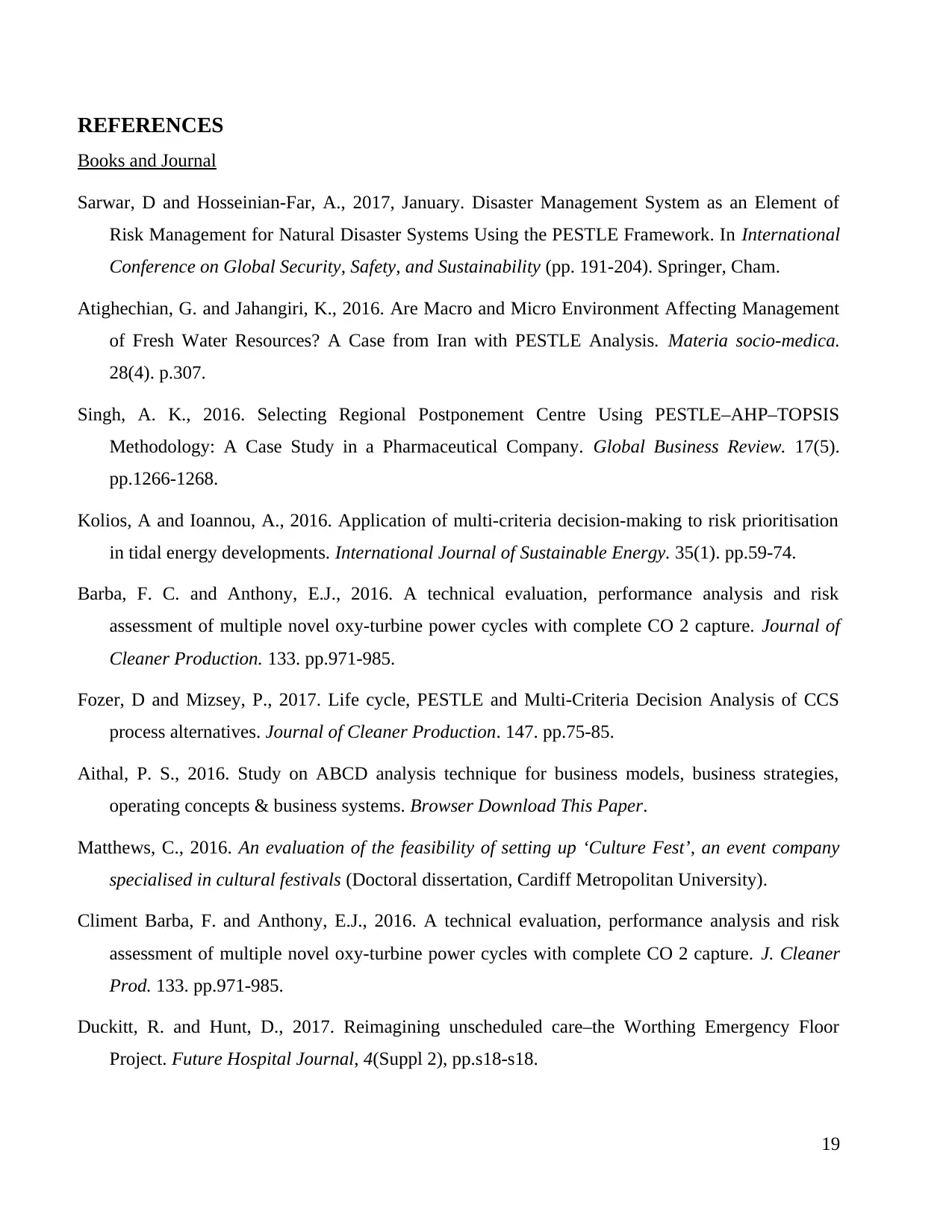
REFERENCES
Books and Journal
Sarwar, D and Hosseinian-Far, A., 2017, January. Disaster Management System as an Element of
Risk Management for Natural Disaster Systems Using the PESTLE Framework. In International
Conference on Global Security, Safety, and Sustainability (pp. 191-204). Springer, Cham.
Atighechian, G. and Jahangiri, K., 2016. Are Macro and Micro Environment Affecting Management
of Fresh Water Resources? A Case from Iran with PESTLE Analysis. Materia socio-medica.
28(4). p.307.
Singh, A. K., 2016. Selecting Regional Postponement Centre Using PESTLE–AHP–TOPSIS
Methodology: A Case Study in a Pharmaceutical Company. Global Business Review. 17(5).
pp.1266-1268.
Kolios, A and Ioannou, A., 2016. Application of multi-criteria decision-making to risk prioritisation
in tidal energy developments. International Journal of Sustainable Energy. 35(1). pp.59-74.
Barba, F. C. and Anthony, E.J., 2016. A technical evaluation, performance analysis and risk
assessment of multiple novel oxy-turbine power cycles with complete CO 2 capture. Journal of
Cleaner Production. 133. pp.971-985.
Fozer, D and Mizsey, P., 2017. Life cycle, PESTLE and Multi-Criteria Decision Analysis of CCS
process alternatives. Journal of Cleaner Production. 147. pp.75-85.
Aithal, P. S., 2016. Study on ABCD analysis technique for business models, business strategies,
operating concepts & business systems. Browser Download This Paper.
Matthews, C., 2016. An evaluation of the feasibility of setting up ‘Culture Fest’, an event company
specialised in cultural festivals (Doctoral dissertation, Cardiff Metropolitan University).
Climent Barba, F. and Anthony, E.J., 2016. A technical evaluation, performance analysis and risk
assessment of multiple novel oxy-turbine power cycles with complete CO 2 capture. J. Cleaner
Prod. 133. pp.971-985.
Duckitt, R. and Hunt, D., 2017. Reimagining unscheduled care–the Worthing Emergency Floor
Project. Future Hospital Journal, 4(Suppl 2), pp.s18-s18.
19
Books and Journal
Sarwar, D and Hosseinian-Far, A., 2017, January. Disaster Management System as an Element of
Risk Management for Natural Disaster Systems Using the PESTLE Framework. In International
Conference on Global Security, Safety, and Sustainability (pp. 191-204). Springer, Cham.
Atighechian, G. and Jahangiri, K., 2016. Are Macro and Micro Environment Affecting Management
of Fresh Water Resources? A Case from Iran with PESTLE Analysis. Materia socio-medica.
28(4). p.307.
Singh, A. K., 2016. Selecting Regional Postponement Centre Using PESTLE–AHP–TOPSIS
Methodology: A Case Study in a Pharmaceutical Company. Global Business Review. 17(5).
pp.1266-1268.
Kolios, A and Ioannou, A., 2016. Application of multi-criteria decision-making to risk prioritisation
in tidal energy developments. International Journal of Sustainable Energy. 35(1). pp.59-74.
Barba, F. C. and Anthony, E.J., 2016. A technical evaluation, performance analysis and risk
assessment of multiple novel oxy-turbine power cycles with complete CO 2 capture. Journal of
Cleaner Production. 133. pp.971-985.
Fozer, D and Mizsey, P., 2017. Life cycle, PESTLE and Multi-Criteria Decision Analysis of CCS
process alternatives. Journal of Cleaner Production. 147. pp.75-85.
Aithal, P. S., 2016. Study on ABCD analysis technique for business models, business strategies,
operating concepts & business systems. Browser Download This Paper.
Matthews, C., 2016. An evaluation of the feasibility of setting up ‘Culture Fest’, an event company
specialised in cultural festivals (Doctoral dissertation, Cardiff Metropolitan University).
Climent Barba, F. and Anthony, E.J., 2016. A technical evaluation, performance analysis and risk
assessment of multiple novel oxy-turbine power cycles with complete CO 2 capture. J. Cleaner
Prod. 133. pp.971-985.
Duckitt, R. and Hunt, D., 2017. Reimagining unscheduled care–the Worthing Emergency Floor
Project. Future Hospital Journal, 4(Suppl 2), pp.s18-s18.
19
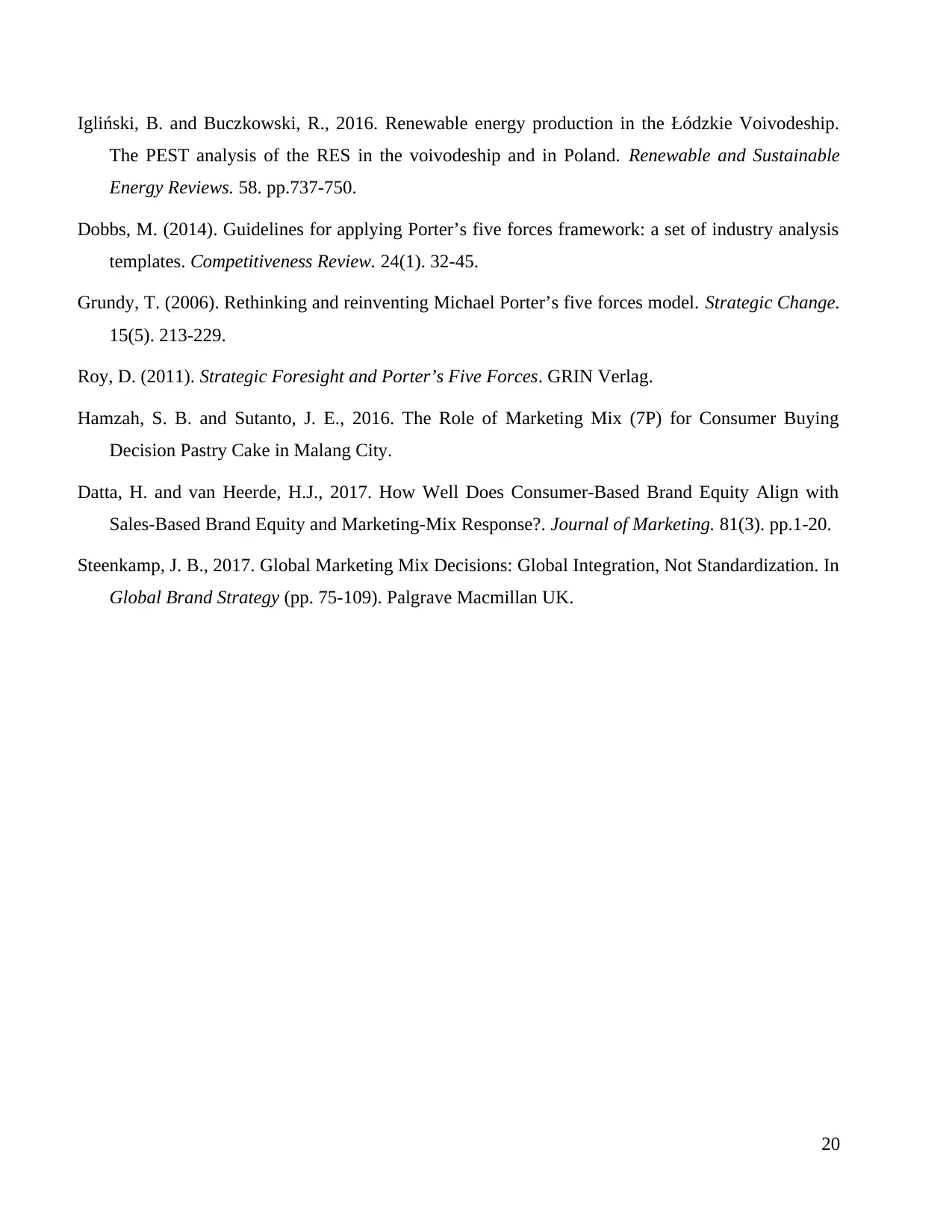
Igliński, B. and Buczkowski, R., 2016. Renewable energy production in the Łódzkie Voivodeship.
The PEST analysis of the RES in the voivodeship and in Poland. Renewable and Sustainable
Energy Reviews. 58. pp.737-750.
Dobbs, M. (2014). Guidelines for applying Porter’s five forces framework: a set of industry analysis
templates. Competitiveness Review. 24(1). 32-45.
Grundy, T. (2006). Rethinking and reinventing Michael Porter’s five forces model. Strategic Change.
15(5). 213-229.
Roy, D. (2011). Strategic Foresight and Porter’s Five Forces. GRIN Verlag.
Hamzah, S. B. and Sutanto, J. E., 2016. The Role of Marketing Mix (7P) for Consumer Buying
Decision Pastry Cake in Malang City.
Datta, H. and van Heerde, H.J., 2017. How Well Does Consumer-Based Brand Equity Align with
Sales-Based Brand Equity and Marketing-Mix Response?. Journal of Marketing. 81(3). pp.1-20.
Steenkamp, J. B., 2017. Global Marketing Mix Decisions: Global Integration, Not Standardization. In
Global Brand Strategy (pp. 75-109). Palgrave Macmillan UK.
20
The PEST analysis of the RES in the voivodeship and in Poland. Renewable and Sustainable
Energy Reviews. 58. pp.737-750.
Dobbs, M. (2014). Guidelines for applying Porter’s five forces framework: a set of industry analysis
templates. Competitiveness Review. 24(1). 32-45.
Grundy, T. (2006). Rethinking and reinventing Michael Porter’s five forces model. Strategic Change.
15(5). 213-229.
Roy, D. (2011). Strategic Foresight and Porter’s Five Forces. GRIN Verlag.
Hamzah, S. B. and Sutanto, J. E., 2016. The Role of Marketing Mix (7P) for Consumer Buying
Decision Pastry Cake in Malang City.
Datta, H. and van Heerde, H.J., 2017. How Well Does Consumer-Based Brand Equity Align with
Sales-Based Brand Equity and Marketing-Mix Response?. Journal of Marketing. 81(3). pp.1-20.
Steenkamp, J. B., 2017. Global Marketing Mix Decisions: Global Integration, Not Standardization. In
Global Brand Strategy (pp. 75-109). Palgrave Macmillan UK.
20
1 out of 22
Related Documents
Your All-in-One AI-Powered Toolkit for Academic Success.
+13062052269
info@desklib.com
Available 24*7 on WhatsApp / Email
![[object Object]](/_next/static/media/star-bottom.7253800d.svg)
Unlock your academic potential
© 2024 | Zucol Services PVT LTD | All rights reserved.





